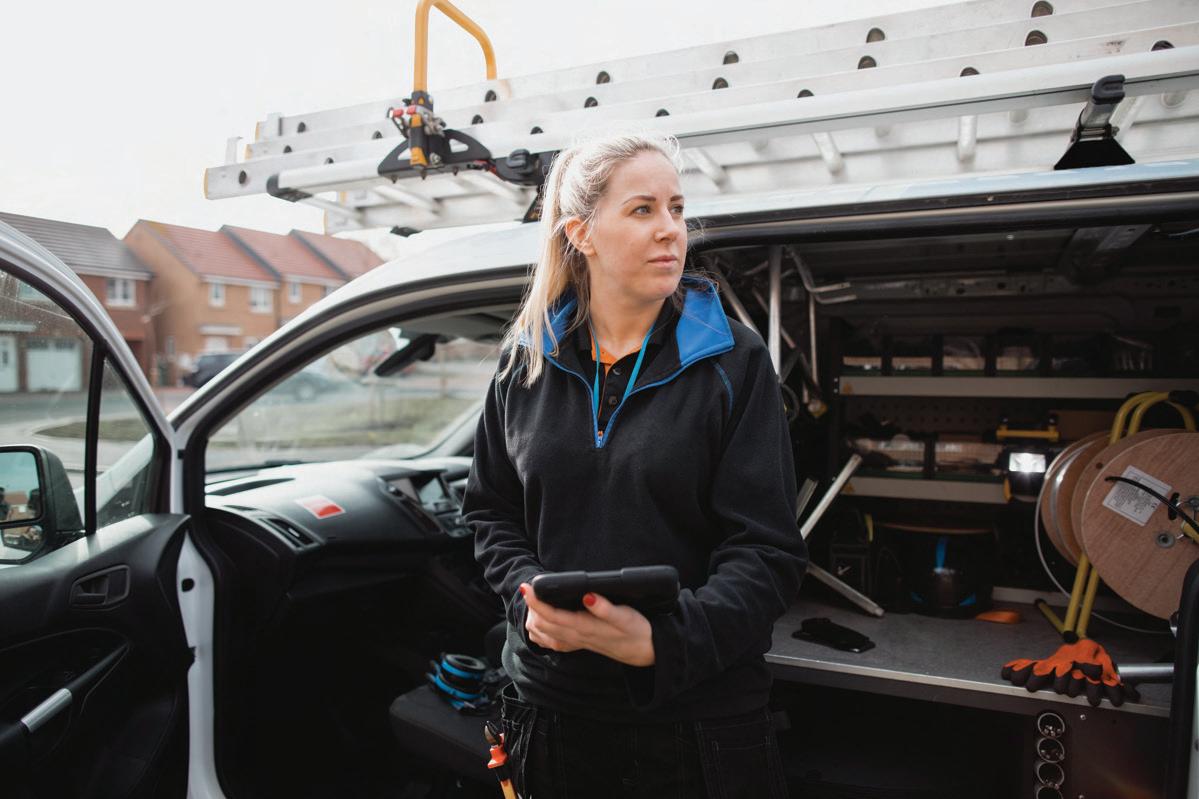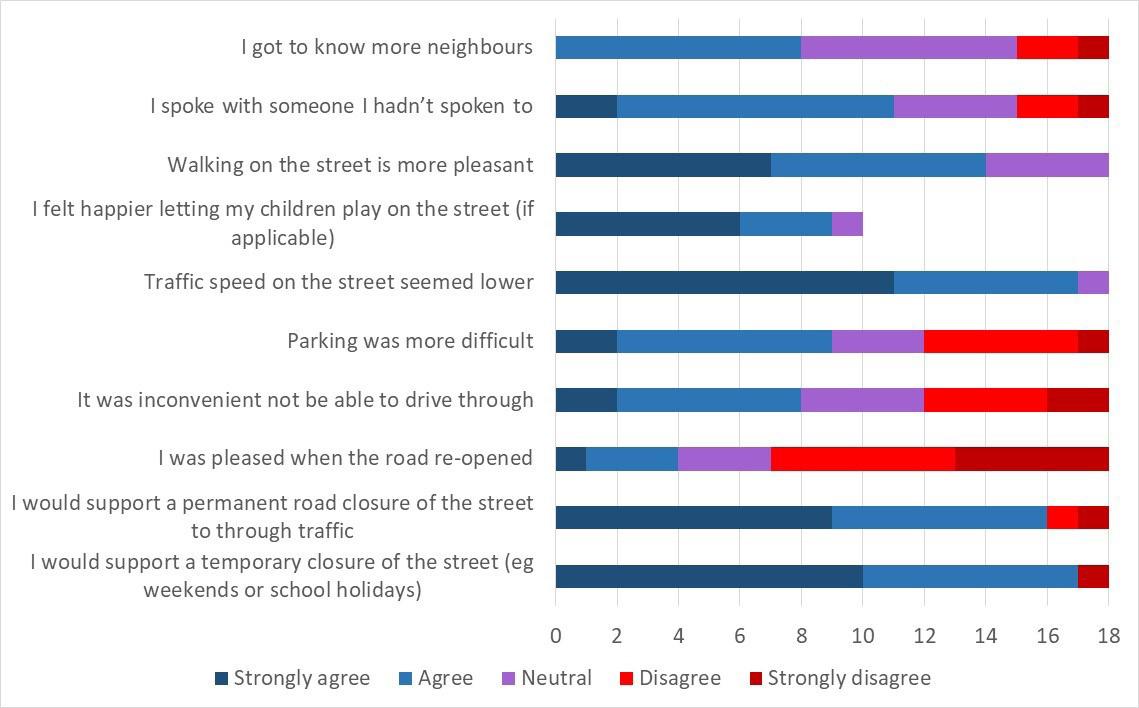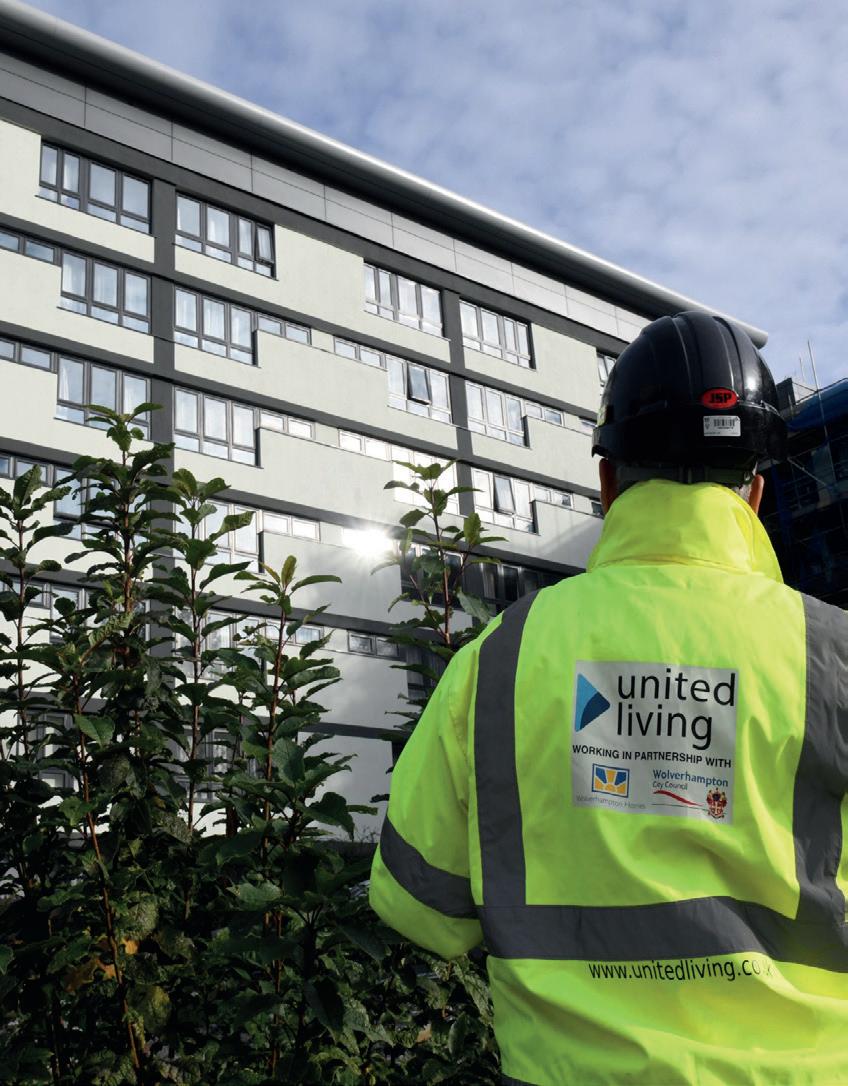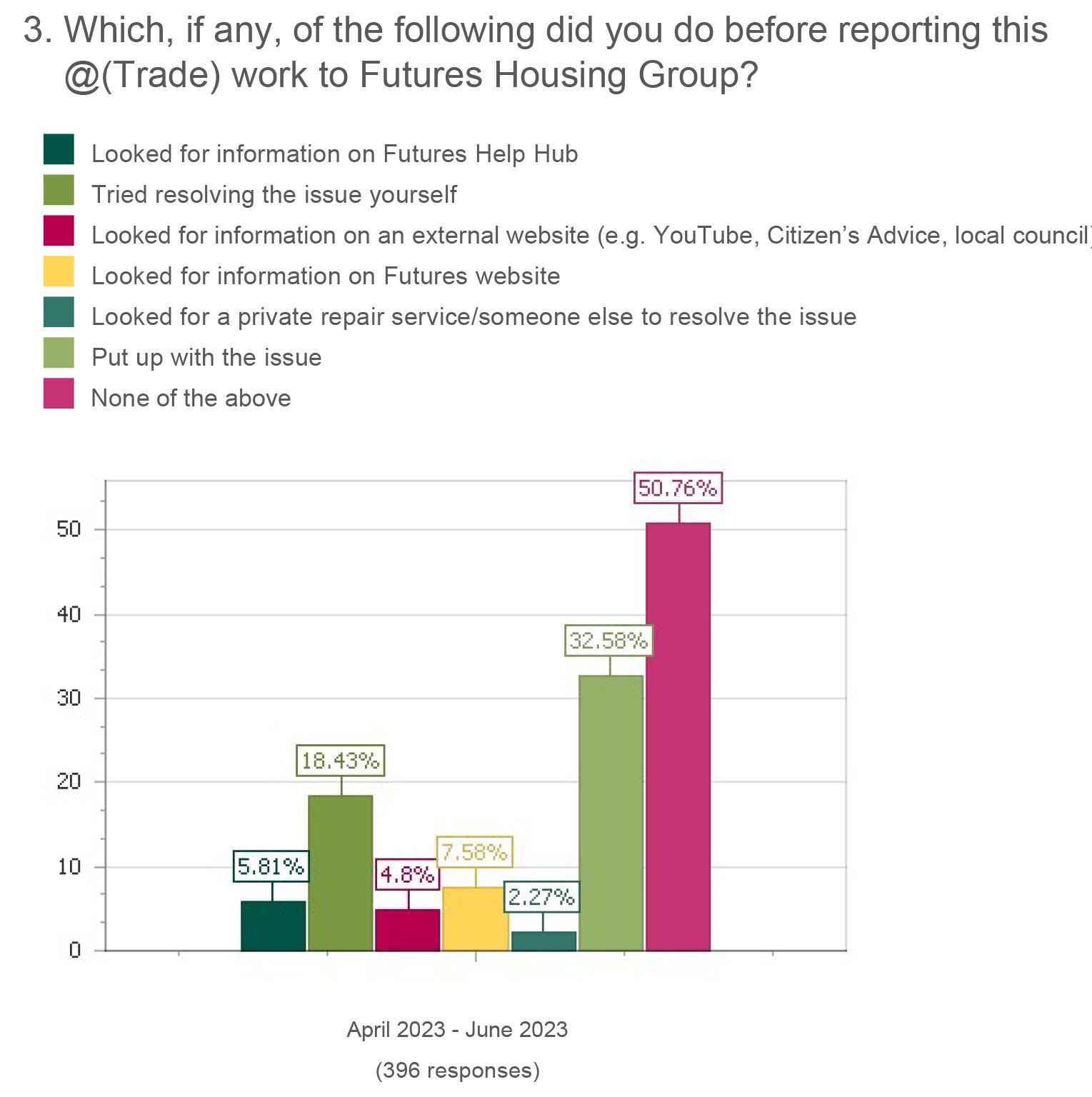ISSUE 14: JULY 2023
Behind the headlines
How a housing asssociation responded to a tower block fire
Housing’s Next Generation
Meet the finalists of this year’s competition
Talking Heads
The social housing professionalisation review

ISSUE 14: JULY 2023
Behind the headlines
How a housing asssociation responded to a tower block fire
Housing’s Next Generation
Meet the finalists of this year’s competition
Talking Heads
The social housing professionalisation review
What to expect from the new era of regulation and inspection
Spend less time on tasks and more time on the personal touches and enhanced experiences that keep your residents happy.
Maintain compliance and make smarter decisions with data you can trust. We’ll help you simplify the complex and use data to the fullest.
Your duties and workload only seem to expand, so every one of our solutions is designed to give you back more of the precious time you need.
Editorial: Alistair McIntosh Jon Land
10 Housing under the microscope
There’s a new regulatory regime coming. What can we expect?
16 Throwing a spotlight on housing inspection
Inspection’s coming back. Alistair McIntosh looks to the future.
32 Housing’s Next Generation: Meet the finalists
The grand finale is imminent – here are the contenders.
36 The Social Housing Professionalisation Review
The views of nearly 50 housing staff.
Bringing you the latest housing research from leading academics, this edition of Evidence looks at densification
Design: Sam Wiggle
All enquiries to: jon.land@hqnetwork.co.uk Tel: 07740 740417
This eco-friendly magazine was produced using 100% recyclable stock.
IncDot Design & Print takes responsibility for our impact on the environment. All our papers and boards are responsibly and sustainably sourced, strictly in accordance with FSC guidelines. The production unit is run chemistry free that meets the most stringent requirements of environmental standard ISO14001.

By the time you read this, the Social Housing (Regulation) Bill may well have received Royal Assent. Mind you, I’ve been saying the same thing since before Easter, so don’t read too much into my crystal ball gazing.
Regardless, if you’re a housing provider, preparations should already be well underway. From next year, we’ll see the biggest changes to social housing regulation since the quango-toasting days of Grant Shapps as housing minister well over a decade ago.
The government’s shift from a hands-off ‘co-regulation/deregulation’ approach to something far more stringent and proactive is long overdue. Born out of the Grenfell tragedy, it’s taken over six years to reach this point and if housing providers don’t know what’s in store, then they haven’t been paying attention to the social housing green and white papers of recent times.
The uncertainty lies in precisely what the new regulatory regime looks like. The bill has evolved during its passage through parliament with the introduction of new elements such as ‘Awaab’s Law’ and we’re still yet to see the final proposals for mandatory qualifications and the new Decent Homes Standard.
Equally, we need to wait for the regulator’s interpretation of the new measures and how they will work in practice. We know from the recent pilots that they took an approach not too dissimilar to the current in-depth assessments to the new inspection regime. We also know that Michael Gove and others in government advocate an ‘Ofsted-style’ approach to inspection that seems to be at odds with the regulator’s interpretation.
No doubt, local authorities and their almos face the biggest challenge in preparing for regulation, as they have largely avoided the scrutiny of the RSH up until now. This not only presents a resource challenge, it’ll also require them to look at the culture of their housing departments as well as the need for councillors and cabinet members to be fully aware of the new regulatory requirements.
In this edition of HQM, we talk to organisations that have been involved in the RSH pilots to gain some insight into the process and the lessons they have learned. And we hear from Alistair McIntosh about the work HQN is doing to help providers prepare for the new era of regulation and inspection.
Elsewhere, we spend a week in the life of Futures Housing Group’s research and intelligence manager as the Tenant Satisfaction Measures get into full swing.
 Jon Land Editor, HQM
Jon Land Editor, HQM
HQN’s new regulation toolkit is designed to help you get ready for the upcoming round of inspections in housing. The work landlords do is under intense scrutiny from social media, the papers, TV and politicians. So, these inspections won’t be an easy ride. Nor should they be. We need to stamp out completely the dreadful cases that have tarnished our reputations.
And there are no shortcuts on the road to recovery. Any attempt at gaming the results will be as futile as it is contemptible. The Regulator of Social Housing (RSH) says it will take a dim view of any landlord that sugar coats their Tenant Satisfaction Measures (TSMs). Meanwhile, the Housing Ombudsman is sharply critical of landlords that only get into gear when he and his team start asking a few questions.
The only way to provide good services across the piece is if all your staff are on side. We need skilled and motivated people who go hunting for problems. Leaders must listen and act on what plumbers, electricians, call centre workers, housing managers and others are telling them. Yes, there have been great advances in the way we use data. But we are a long way off automating housing management. It will always rely on humans. You need well-informed and motivated staff to prove to inspectors that your services are strong day in and day out.
Our toolkit is based on pilot inspections HQN has been running. You can read more about those on page 16. Some of the pilots have been with landlords that do indeed face sharp criticism. What’s striking is how quickly you can diagnose problems. That’s because the leaders and staff we work with are under no illusions about where the issues lie. And they’re honest and open, so they tell us all about it. We go to great lengths
to talk to tenants, and it’s not surprising that tenants and frontline staff make very similar points. Improvements will not come about instantly. As the saying goes, Rome was not built in a day.
The art of management will be in developing improvement plans that tenants and staff can have confidence in. That will not be easy, as patience is in short supply. But you can spot an improvement plan that’s fanciful a mile off: it won’t deliver for tenants and it won’t placate inspectors either.
Our general advice is to track all your TSMs and compare these with peers as quickly as you can. That will maximise the time you have available to understand and correct any adverse trends. HQN is far from alone in being concerned about diversity. We expect that the satisfaction figures for black and brown tenants will be low. It’s time to get to the bottom of this and do better. Michael Gove was unimpressed with the warm words from Rochdale Boroughwide Homes versus the reality of the poor services doled out to black and brown tenants. Very often, black and brown staff satisfaction isn’t great either. Work to do.
We’ll only get our reputation back when all our staff and leaders are pulling in the same direction for tenants. Let’s hope that government helps by finding a way to assist landlords to improve. We have an endless supply of sticks today, but no carrots at all.
We hope you find the toolkit useful and please let us know if we can help you out with more hands-on support.
Alistair McIntosh, Chief Executive, HQN“Developing improvement plans that tenants and staff can have confidence in will not be easy, as patience is in short supply. But you can spot an improvement plan that’s fanciful a mile off: it won’t deliver for tenants and it will not placate inspectors either”


Field Service Management technology that is trusted by leading organisations to transform service delivery and provide extraordinary results.

Through working with Totalmobile, housing providers are:
Mitigating against the risk of disrepair claims
Providing more efficient and timely repairs and maintenance services
Enhancing the visibility and management of contractors
Creating more sustainable processes for field workers and end users
See how our integrated solution which includes job management, mobile and scheduling capabilities can help your organisation: marketing@totalmobile.co.uk




In our new series, we hear from housing providers involved in major news events to understand how they handled difficult situations and what lessons have been learned. Here, Sue Sutton, Chief Executive at Salix Homes, explains how a fire in a Salford tower block prompted the housing association to launch a campaign to raise awareness of the dangers posed by e-bikes and e-scooters powered by lithiumion batteries.

It was shortly after 8am on the day after Boxing Day when the call came through.
As the CEO of a social housing provider with 19 tower blocks in Salford, it’s the phone call you always fear: one of our blocks was on fire.
Greater Manchester Fire and Rescue Service (GMFRS) were at the scene at Mulberry Court in Pendleton within minutes, as smoke and flames billowed from a 10th floor

window. At the height of the incident, there were six fire engines and dozens of firefighters.
Thankfully, no one was hurt. Several floors were safely evacuated, and crews successfully extinguished the fire, containing it to the flat where it started.
Since the Grenfell Tower tragedy, Salix Homes has carried out extensive building and fire safety improvements across all our tower blocks in Salford. No-one ever wants to test these fire safety measures in a real-life situation; however, this was the ultimate test and, fortunately, the building performed as it should. Thanks to the sterling efforts of the fire service and the building’s safety measures, including the early warning alarm system which alerted the fire service directly, the fire didn’t spread.
However, the cause of the fire presents a new and growing risk for housing associations and our residents: it was started by a faulty e-bike battery that had been charging in the bedroom.
Last year, GMFRS attended 14 fires that had been sparked by e-bikes and e-scooters, an increase from eight in 2021 and three in 2020.
E-bikes and e-scooters are powered by rechargeable lithium-ion battery packs. These batteries are used safely in everyday devices that most of us own – watches, laptops, mobile phones.
The problems arise in non-standard or faulty batteries, which aren’t being charged safely. They’re a major fire risk when over-charged, short circuited or damaged, and when they do catch fire, the consequences can be deadly: across the UK, eight people have been killed in e-bike and e-scooter-related fires.
The fire at Mulberry CourtE-bikes and e-scooters are soaring in popularity – they’re a cheaper and greener mode of transport, and we’re seeing more of our tenants owning and using them.
We’ve recently launched an e-bike safety campaign for our residents in Salford to warn them of the potential dangers and provide guidance to ensure they’re being used and charged safely and responsibly.
Our guidance includes not charging them while you’re sleeping, never blocking your escape route with the bike, and only buying from reputable manufacturers.
As part of the campaign, we’ve shared pictures of the fire damaged flat to help highlight the potential dangers. The images are shocking and quite sobering, with just the charred remains of a metal bed frame still visible.

The ferocity at which these lithium battery fires take hold and the devastation caused is alarming. It’s a not a slow burn – they literally explode and burn ferociously, reigniting as they go. This incident caused £90,000 damage at our tower block.
Most e-bikes and e-scooters on the market in the UK bought from reputable manufacturers meet the stringent safety regulations – but many of the safety issues are arising from converter kits, which are non-standard lithium-ion battery packs designed to convert a standard bike to an
e-bike. There are growing concerns about these converter kits sold cheaply online, which don’t meet UK safety regulations and present an increased fire risk.
Ultimately, stronger regulation is needed on their sale and use, but until then it’s paramount that housing associations, and other landlords, warn residents about the potential dangers and help make sure they’re taking the necessary steps to ensure they’re not putting peoples’ lives or homes at risk.
You can find out more about Salix Homes e-bike safety campaign on our website.
 Salix Homes has launched an e-bike fire safety campaign
The damage caused by an e-bike fire at Mulberry Court
Salix Homes has launched an e-bike fire safety campaign
The damage caused by an e-bike fire at Mulberry Court
“The ferocity at which these lithium battery fires take hold and the devastation caused is alarming. It’s a not a slow burn – they literally explode and burn ferociously, reigniting as they go. This incident caused £90,000 damage at our tower block”
With the Social Housing (Regulation) Act finally completing its passage through parliament, social housing providers are gearing up for a bold new era of proactive regulation. And, as Neil Merrick discovers, preparation is key – for both the organisations under scrutiny and the regulator itself.
During the past 13 years, the government has spent as much time rejecting the need for social housing regulation as it has extolling its virtues.
In 2010, then housing minister Grant Shapps declared the Tenant Services Authority “toast”. In the same year, the embryonic National Tenants Voice was scrapped and the abolition of the Audit Commission was announced.
Grenfell was still seven years away. In 2018, a green paper paved the way for the 2020 white paper (or charter for social housing residents), which heralded a major mood swing. Suddenly, tenants mattered, with the spotlight shone on service quality, not least by a newly empowered Housing Ombudsman.
Now, the mother of all U-turns is almost complete. Since April, landlords have been required to ensure that tenants are listened to on a regular basis. Within a year, inspectors (or regulators) will be armed with fresh consumer standards that will be used to hold
organisations to account from next summer.
So, what does this dramatic volte-face mean for social landlords, especially local authorities that have largely escaped attention for the past decade?
Towards the end of last year, Eastbourne Council was among seven landlords that took part in the first round of pilot inspections for the Regulator of Social Housing.
As local authority housing departments go, Eastbourne is unusual. Not only does it have an arm’s length management organisation, but it shares services with neighbouring Lewes Council, which wasn’t inspected.
While robust, the inspection wasn’t as onerous as those by the Audit Commission, says Richard Tomkinson, customer experience and performance improvement lead for housing across the two authorities. “We learned that in-depth assessments aren’t something to be feared,” he says.
2010 Newly-elected coalition government abolishes Tenant Services Authority and National Tenant Voice
2010 Government confirms it plans to abolish Audit Commission; Homes and Community Agency takes over economic regulation of housing associations
2015 HCA introduces new regulatory standards, with associations required to test their own resilience; Audit Commission is wound up
2018 Regulator of Social Housing replaces HCA regulation committee; green paper paves way for tenants to be given more say over landlord decisions
2020 Charter for social housing residents promises more tenant scrutiny; Housing Ombudsman takes on new powers
2021 Regulator consults over Tenant Satisfaction Measures (TSMs)
2022 Social Housing (Regulation) Bill introduced in parliament
2023 Landlords start consulting tenants in line with TSMs; regulator to revise consumer standards ahead of first inspections in 2024.
According to Tomkinson, the pilot inspection was as much of a learning experience for the regulator as it was for Eastbourne, which set up a customer experience team five years ago to co-ordinate tenant feedback. “It’s not something that you need to worry about or for which you must over-prepare,” he adds.
The Department for Levelling Up, Housing and Communities has compared RSH inspections with those of Ofsted. Kate Dodsworth, chief of regulatory engagement at the Regulator of Social Housing, sees “similarities” between Ofsted inspections and in-depth assessments by her regulators (the RSH doesn’t use the term ‘inspectors’).
Her teams will examine documents and hold senior management teams to account, just as school inspectors do. The important thing is that the RSH will no longer need to apply a ‘serious detriment’ test before checking on landlord services. “It allows us to go in on the front foot,” she says.
Since being set up in 2018, the RSH has investigated up to 300 possible breaches of consumer standards each year. This is on top of checking that housing associations (but not councils) meet economic standards.
During the past five years, it found 47 breaches, including 28 by councils. Half of the breaches by councils have been identified since April 2022.
The new regulation system is based around 22 tenant satisfaction measures (TSMs) that landlords began applying in April. This gives regulators the tools to discover how tenants feel
about their homes and levels of service, says Dodsworth, though they may be required to use qualitative rather than quantitative judgements.
She also expects dissatisfied tenants to continue referring landlords to the regulator, and for more landlords (including more councils) to refer themselves, prior to any inspection taking place.
“For local authorities, there’s a period of time to build up a relationship with us and undertake self-referral,” she says. “The coming consumer regulation has raised consciousness at board level and council meetings.”
In addition to Eastbourne, only one of the other landlords involved in the first inspection pilot, Folkestone and Hythe, was a local authority [see box]. Among the five housing associations taking part was Bernicia Homes.
Andrea Malcolm, Bernicia’s executive director for people, homes and communities, says the pilot allowed the association to demonstrate how it listens to tenants and reflects their feedback through its services.

There has been speculation about landlords ‘gaming’ the system to achieve better TSM scores. Best to avoid online perception surveys, it is said, or asking tenants for their opinions in the depths of winter.
“I know people who are gaming the system to maximise their results,” says Malcolm. “I’m more
“For local authorities, there’s a period of time to build up a relationship with us and undertake selfreferral. The coming consumer regulation has raised consciousness at board level and council meetings”
Kate Dodsworth, chief of regulatory engagement, Regulator of Social Housing
interested in getting a legitimate response so that we can direct resources so they best serve tenants.”
Dodsworth warns the RSH will look out for gaming of survey data and, in any case, is as interested in how landlords respond to feedback as the results themselves. “We are outcome focused,” she says.

But what if things get competitive? The government dropped plans for league tables of social landlords almost as soon as the ink dried on the 2018 green paper. But the media and others are bound to make comparisons where they can.
In May, Sutton Housing Partnership proclaimed its tenant satisfaction scores to be the best in London. Eamon McGoldrick, managing director of the National Federation of Almos, says it’s unlikely councils or almos will be shy to publicise good results, especially with politicians around.
“The media will produce league tables,” he says. “If almos are doing a good job, then they will claim the glory.”
According to McGoldrick, almos that once contended with the Audit Commission’s key performance indicators have nothing to fear from enhanced scrutiny. But in the case of almos, it’s the parent council that regulators will ultimately hold to account.
Last year, South Tyneside Homes paid a marketing company £12,000 to carry out a tenants’ survey using draft TSMs. This revealed general satisfaction, but the need to deal with complaints faster. A scrutiny panel carries out up
Ten tenant satisfaction measures assessed directly by landlords:
• Homes failing decent homes standard
• Repairs completed within target time
• Gas safety
• Fire safety
• Asbestos safety
• Water safety
• Lift safety
• Complaints received
• Time taken to respond to complaints
• Antisocial behaviour.
Twelve TSMs assessed by tenant perception surveys:
• Overall satisfaction
• Repairs
• Time taken to complete most recent repair
• Maintenance of home
• Safety
• Landlord listens to tenants’ views and acts on them
• Landlord keeps tenants informed about things that matter
• Landlord treats tenants fairly and with respect
• Landlord’s handling of complaints
• Communal areas
• Landlord’s contribution to neighbourhoods
• Landlord’s approach to antisocial behaviour.
“I know people who are gaming the system to maximise their results. I’m more interested in getting a legitimate response so that we can direct resources so they best serve tenants”
Andrea Malcolm, executive director for people, homes and communities, Bernicia Homes
to four checks per year, while a wider ‘check and challenge’ group reviews specific services.
Paul Mains, the almo’s managing director, is waiting to see how regulators attribute the quality of landlord services to a council, when services are delivered by an almo. “Maybe it will become self-evident,” he says.
The RSH is yet to reveal exactly how, or even whether, landlords will be graded. “I think everybody would expect us to leave organisations with some sort of grade or overview,” says Kate Dodsworth.

Landlords are under pressure to not just listen to tenants more, but to listen to a larger number of them. The Confederation of Co-operative Housing won a two-year DLUHC contract to flag up the need for wider scrutiny through its four million homes programme
This includes free training for tenants, online and face-to-face. Blase Lambert, the confederation’s chief officer, wants to see consultation “democratised”, meaning tenants can properly shape services.
“We need to move beyond how the sector has operated for decades, which engaged a small number of residents, but didn’t allow the voices of four million households to be heard,” he says.
The new world of housing regulation comes at a cost, not least to the RSH, which expects to take on about 100 extra regulators. It currently
employs 224 staff, 130 of which are in regulatory roles.
Landlords received government funds towards this year’s surveys, but the cost of expanding scrutiny may need to be met from existing budgets. Some landlords may be in for a shock as the first results roll in and inspections loom.
Mathew Warburton, policy adviser at the Association of Retained Social Housing, accepts some council housing departments have taken their eye off the ball, but says the picture across local government is mixed. He’s concerned that, to satisfy regulators, councils may need to check every property each year. “That raises huge resource issues,” he says.
Landlords will be expected to keep improving as well as meeting high standards in the first place. In Eastbourne, Richard Tomkinson says: “We’re confident that we can meet the challenge of an in-depth assessment but, next time, we want to demonstrate that we’ve made further progress.”
Ultimately, the new system isn’t just about placating residents or identifying failure, but discovering what works well. Confident landlords should be happy to undergo scrutiny if criticism is fair and money available to address failings. “If you’re delivering a service that isn’t valued, it’s not a good use of money,” says Andrea Malcolm.
“If they’re dissatisfied with refuse collection or park management, then their net satisfaction with the neighbourhood is likely to be lower. That presents a challenge for us in working with colleagues in the rest of the council to ensure we increase tenant satisfaction”
Gill Butler, chief officer for housing, Folkestone and Hythe District Council
During the three years since bringing its housing management service back inhouse, Folkestone and Hythe District Council has had regular contact with the Regulator of Social Housing.
The council was one of four local authorities whose homes were managed by East Kent Housing, an arm’s length management organisation wound up in 2020. Having inherited a regulatory notice for non-compliance with consumer standards, it made health and safety improvements and, after referring itself to the RSH, saw the notice lifted the following summer.
Since 2020, the focus has been on creating a completely new service to manage its 3,400 homes. “We started from scratch,” says Jonathan Hicks, the council’s senior specialist for policy and performance.
Three years on, it’s one of just two local authorities with first-hand experience of the regulator’s approach to consumer inspections, having been invited to join a pilot at the end of last year.
A team of three regulators joined a meeting of its strategic tenants’ advisory panel. They also interviewed senior staff and the cabinet member for housing, as well as visiting independent living accommodation for elderly residents.
Regulators found good evidence of compliance with existing consumer standards and praised the council’s commitment to putting tenants at the heart of its housing
service. No indicative grade was given.
The pilot’s purpose was twofold, with regulators examining whether their framework is fit for purpose. “It was a test for them and their framework as much as it was a test for us,” says Hicks.
Folkestone and Hythe carried out a tenant survey after re-establishing its housing management service, and again last year, using draft tenant satisfaction measures.

The important thing, says chief officer for housing Gill Butler, is to tap into tenants’ experience, though it is difficult to estimate the precise cost. This year, the council received £11,476 from the DLUHC towards tenant consultation.
Its three-year tenant engagement strategy, published in 2021, promises to set up a ‘tenants’ voice’, to work with the council at strategic level. Further options include snap surveys, mystery shopping, and joint inspections with tenants.
Early indications suggest that tenants don’t generally distinguish between services provided by the housing department and those that fall under the wider council.
“If they’re dissatisfied with refuse collection or park management, then their net satisfaction with the neighbourhood is likely to be lower,” says Butler. “That presents a challenge for us in working with colleagues in the rest of the council to ensure we increase tenant satisfaction.”
The social housing sector is braced for the return of inspection in some form. But whether it’s ‘Ofsted-style’ as the government prefers or an extension of the current ‘in-depth assessment’ approach remains to be seen. Either way, organisations need to start preparing now – as Alistair McIntosh explains.

My wife is a director at one of the G15 housing associations and is under a certain amount of pressure at the moment. So, I get how hard people are working. I get how many complaints there are. I get how much political interest there is.
It’s a tough old world to operate in and, unfortunately, with a general election at some point in the next year, it’s only going to get more intense. The level of scrutiny is unlike anything we’ve seen before. And into that comes inspection.
We’ve run a couple of our own pilot exercises and I’ve spoken to many of the regulator pilots. I’ve also spoken to the regulator. We’ve been tracking this pretty carefully over the last couple of years because it’s important that members of HQN, as the name implies, do well at inspection.
There are 200 new staff at the Housing Ombudsman to cope with the incredible backlog of work that they’ve got. Goodness knows if they’ll ever clear it, because those complaints reports they put out, whether you agree with them or not, are certainly very detailed.
We also have 100 extra staff being recruited by the Regulator of Social Housing and that will take them up to about 200 – the old housing inspectorate at its peak had 120 staff, so already this is a bigger operation. And, of course, in those days, the ombudsman wasn’t as active as it is now.
It does beg the question whether the ombudsman and the regulator will ever come together formally in some sort of merger? As some of you will be aware, the ombudsman is referring cases to the regulator, which the regulator is then duty bound to investigate.
So, they’re already joined at the hip as one organisation to all intents and purposes.
I expect that the social media campaigns we’ve seen over the last 18 months will continue and that the ombudsman and regulator will have to respond to the intensity of those campaigns and the political support they get as we go along.
So, the pressure will continue from both
formal and informal mechanisms. And it’s the informal mechanisms that sparked Michael Gove into action.
Gove is especially interested in Grenfell and you wonder if it’s a reflection of the Piper Alpha disaster, which certainly affected Aberdeen where he was brought up in his youth. He’s written extensively about Piper Alpha in the past. Quite a traumatic formative experience. Even in Glasgow, I remember the Grampian police cars coming round in the early hours and that’s how we knew something was amiss.
Gove coined the phrase ‘Ofsted-style inspection’. Interestingly, if you look at Jeremy Hunt’s new book, which is his reflections on the health service, he has a whole chapter on how difficult it is to use targets meaningfully. Too few, too many ‘gaming’, all the rest of it. But his conclusion is that Ofsted-style inspections are the way to go. If the indicators aren’t telling you everything you need to know, then you must go in and inspect the organisation and draw some conclusions on the ground.
Talking to one of the pilot organisations, they were pretty pleased at how straightforward it was but, when they reflected on it, they realised how much they’ve done on assessing their performance against the consumer standards beforehand. I expect it will be more difficult in the future when the inspectors have more experience and more wherewithal, but preparation is the big lesson from that particular pilot.
The housing inspector in the past would rely on short notice inspections to deal with recalcitrant landlords that would perhaps benefit from an ambush. The regulator doesn’t need to bother with any of that. It can downgrade, it can issue notices, it can take action without visiting a single home or going anywhere near you. And you’ve seen that in the past on defects on data and safety.
Now, the regulator isn’t going to be prescriptive, but you’ve got to know your homes inside out and understand what work needs to be done and where the safety issues are. They’re not going to tell you which surveyor to go to, or which method to use, but they will seek assurance that you know the problems across your stock and
“I have to visit as many estates and talk to as many people as I can. I’ve cycled around the boroughs so much, I should have the calves of Jack Grealish, but, sadly, that’s not the case”
that you’ve funded plans to deal with those.
Stock survey requirements are changing. In the past, housing associations have asked for stock surveys in order to raise finance. When you’re doing that, it’s perfectly all right to clone properties because it’s purely for the purposes of a business plan and lending collateral. When you are surveying properties to satisfy the regulator that know your onions, you’ve got to visit all the homes and get reliable data on them, preferably vetted by someone independent.
You then need to tie that to information about individual vulnerabilities of households. Time and again, landlords get caught about having folk in poor conditions with damp and mould and they weren’t aware of elderly people, asthmatic people, children in those properties.
There’s been a recent spate of ombudsman cases which boil down to vulnerable people living in poor-quality homes. The ombudsman then refers that to the regulator. The regulator then writes to the landlord and seeks the relevant information.
Complaints handling is a very big deal. The advice I’d give is never delegate complaints handling to junior people. Complaints handling has to be dealt with at a senior level in the organisation and if you don’t do that, you’ll be caught out time and time again. So, a lot of effort has to go in, even at the stage one complaint stage, to make sure that you really are on top of things and not just relying on processes.
Now, you’re probably saying, that’s all very well, Alistair, but we’re not going to sign a massive cheque; we’re not going to get this stock survey done anytime soon. I agree with all that. You must have some plans in place to undertake a survey, albeit over a period of time.
Housing associations don’t have a leg to stand on because the value for money standard that already applies to them has required a granular analysis of stock since the year dot. Local authorities might have a bit more wiggle room.
A lot of landlords are using Microsoft Power BI to identify trends of disrepair and complaints on estates. They then visit these estates and see if there are more similar cases and check that their data is valid and up to date. In addition to
this, what we find hugely valuable is listening to the operatives, the call centre workers, area managers, local finance agencies, et cetera. They will tell you where the problems are. It’s not difficult to identify the problem blocks. You’ve also got to listen to tenants and if you do all that, you’ll be there or thereabouts.
So, it’s a bit like building the bridge from both ends. The plan is to get the full survey done, but in the interregnum, working with the people you’ve got, and the information you’ve got, to build up a picture so that you’re not caught out. And of course, learning from complaints is an important part of that.
Moving on, if you’re deficient on safety, then you may have to self-refer to the regulator. The system is known as co-regulation. And that means it’s your job to inspect yourself. If you identify shortcomings on safety, you have to assess whether you’ve failed the home standard. It’s your job to tell the regulator. People take different approaches to this. There are a few chief executives out there who self refer every flipping week. There are others that are perhaps a little bit more recalcitrant, but the key thing is to get across to the regulator any deficiencies you’ve got on safety.
Now, local authority people say to me there’s no incentive to self-refer. The way I characterise it is like this: if you self-refer to the regulator, you get ten of the lash. If you don’t self-refer, you get 50 of the lash. They do prefer to be kept in the loop. And don’t forget, it’s not just the property –it’s communal areas too.
In order to get this right, get hold of all the ombudsman reports on record keeping. They’re very important. The regulator knows all the
“I read some dross reports from local authorities and housing associations. Let’s lift the quality of those reports. You know what to do. Staff training is an important one. We need to listen, hear and act on what tenants and frontline officers are saying”
tricks about insufficient sample sizes and all the sort of weasel words that are put around about the levels of assurance. So, for the love of God, do please read your internal audit reports before you send them on to a third party.
So, what information is the regulator seeking from the pilot organisations before it goes in? Well, when they go to a housing association, they ask for all the governance and financial information they would for in-depth assessments, because they twintrack the checks on the economic standards and the consumer standards.
For local authorities, it’s somewhat more confused. The governance standard doesn’t apply, but they’re still looking for assurance from the cabinet or similar body. So, you’ll have to provide some summary of who gets assurance and how.
And although the viability standard doesn’t apply, I would suggest that because the self-financing settlement made no adjustment for dealing with tower bocks, the government in effect left a few councils in what the regulator would characterise as its lowest financial ratings of V3 and V4.
It’s fair to say, you couldn’t describe the inspections that have taken place so far as ‘Ofsted-style’. We’re aware of the situation where the politicians have been pushing the regulator to go further and faster. The regulator is rightly proud of its role on financial stewardship. The housing associations don’t necessarily want to dilute the quality there, so I think we’re a way off what we’ll ultimately see. But lessons have been learned.
We’ve seen different themes at different pilots. Repairs at one, domestic abuse at another. At the housing association pilots, there’s a lot of focus on board members. One pilot said, it’s almost as if the executives have been locked out of the process. So, again, training for board members is important. It’s been a bit more free and easy at the councils and almos thus far, but I think we need to get those folk up to speed.
Data and compliance are the big deals. The pilots have had variable feedback, but the game is on when the guidance comes out on inspection from the regulator, hopefully sometime in the summer.

Diversity is important to the regulator. Rochdale had fantastic stuff on its website about how good they were at dealing with black and brown people. The reality was very different. Transparency is all about how easy it is for the tenants to find out what’s going on and understand how they should be approaching things.
With the HQN pilots, we don’t quite lift every rock, but we have to be as thorough as we can. I’m working on the assumption that they’ll go in with Kwajo-like intensity. The regulator has the ability
“With the HQN pilots, we don’t quite lift every rock, but we have to be as thorough as we can. I am working on the assumption that [the regulator] will go in with Kwajo-like intensity”
to sample, but we don’t know in advance what that sample will be. They could use intelligence from Power BI; they could use complaints from the ombudsman. They’ll build up experience. Some of the folk at the RSH do know the job very well. They’ve got former housing association chief executives and former audit commission inspectors, so they’re not green.
They’ll be good at this, but I cannot second guess where they’re going. While the regulator may not visit individual homes, they will seek assurance that landlords know them inside out. So, I have to visit as many estates and talk to as many people as I can to check landlord awareness. I’ve cycled around the boroughs so much, I should have the calves of Jack Grealish, but, sadly, that’s not the case.
But we struggle, as does the regulator, in getting beyond the engaged tenants. We always start from the frontline. It’s an awful lot quicker than talking to the board, because people know the blocks, they know the issues. And in the olden days of inspection, we used to make up great scenarios for mystery shopping to test the call centre. Now we just listen to the recordings and they’re brilliantly insightful. I also find with councils that talking to the unions provides great information. They are especially strong on the need for training and the importance of boosting staff recruitment and retention.
And although the value for money standard doesn’t apply to councils, it sort of does. Picture the scene: the regulator comes in, your services aren’t up to scratch. The council says, “Hang on, we didn’t have enough money to spend”. The regulator says, “Yeah, but what about that rent increase you didn’t pass on? What about money you wasted on a local housing company?” And on and on it goes. So, my advice to the local
authorities is to work as if the value for money standard applies and have your arguments ready to demonstrate that you truly are short of cash and managing your assets as effectively as possible.
Now, the problem with councils is I can go in and say, you’re not spending enough on the properties, please fix this. And then the leader or someone else will say, “It’s all very well, Alistair, but what about the folk who are in bed and breakfast or the private rented sector in worse conditions? We’re a council, we have to balance our priorities.” Some very difficult issues there.

The regulator is going to have a tough job inspecting large associations across multiple areas. They’ve properties here, there and everywhere. How do you decide where to inspect and what weight to place?
I read some dross reports from local authorities and housing associations. Let’s lift the quality of those reports. You know what to do. Staff training is an important one. We need to listen, hear and act on what tenants and frontline officers are saying.
And that last point is one that underlines the importance of ensuring boards and cabinet members are totally in the loop. Get hold of those complaints at the start. Get senior folk involved. Don’t let matters fester.
“Local authority people say to me, there’s no incentive to selfrefer. The way I characterise it is like this: if you self-refer to the regulator, you get ten of the lash. If you don’t self-refer, you get 50 of the lash. They do prefer to be kept in the loop”
To help social housing providers prepare for the new regulatory regime, HQN has provided a quick guide on how to comply with the consumer standards. The following tips are designed to be used alongside our comprehensive new social housing regulation toolkit, which is now available to all HQN members.
• Ensure you are on top of fire safety in your high rise blocks
• Ensure compliance with the ‘big five’ – gas, electricity, fire, asbestos and water. Plus lift safety where appropriate
• Ensure comprehensive, accurate and up-to-date data on safety. Carry out regular audits
• Find out residents’ views about their safety. Act on what they tell you
• Learn from complaints. They could mean problems might not be ‘one off’ incidents
• Ensure your board/governing body understands their responsibilities in delivering safe services
• Learn good practice from public, professional and trade bodies
TSMs
BS01 Gas safety checks
BS02 Fire safety checks
BS03 Asbestos safety checks
BS04 Water safety checks
BS05 Lift safety checks
TP05 Satisfaction that the home is safe
• Meet the current Decent Homes Standard – and gear up for new DHS
• Seek assurance that your data is comprehensive, accurate and up to date
• Measure satisfaction with repairs and act where residents identify failings
• Learn from residents’ complaints. Remember that complaints can identify generic problems
• Ensure you’re on top of damp and mould problems. Keep policies and practices under regular review. Monitor implementation
• Ensure your board/governing body understands their responsibilities in asset management strategy. Inform them about repairs performance
• Learn from others about the best ways of investing in, repairing and maintaining stock
• Ensure you have effective, customer focused aids and adaptations policies and procedures
TP02 Satisfaction with repairs
TP03 Satisfaction with time taken to complete most recent repair
TP04 Satisfaction that the home is well maintained
RP01 Homes that do not meet the Decent Homes Standard
RP02 Repairs completed within target timescale
• Adopt policies and practices on neighbourhood management for individual estates/localities
• Listen to residents about their experiences, especially on ASB and neighbourhood management
• Ensure you are working effectively with other organisations to tackle domestic violence
• Ensure your data is location specific and supports you to address resident concerns
• Hold regular estate inspections involving residents, boards/governing bodies and senior staff and address any problems
• Learn from and respond positively to complaints on ASB and neighbourhood management issues
• Make sure other agency partners are fully on board with your aims and objectives
• Ensure your board/governing body understands their responsibilities in managing neighbourhoods and tackling ASB
• Adopt good practice that others have developed
TP10 Satisfaction that the landlord keeps communal areas clean and well-maintained
TP11 Satisfaction that the landlord makes a positive contribution to neighbourhoods
TP12 How satisfied or dissatisfied are you with your landlord’s approach to handling antisocial behaviour?
NM01 Anti-social behaviour cases relative to the size of the landlord
• Make sure your data is correct. Check and double check figures
• Learn from data and improve services showing below par performance
• Revisit how you present performance data to residents via the new TSM framework
• Show residents you can disaggregate data down to estate level so it’s more meaningful
• Share performance data beyond TSMs with residents – eg, rent arrears, voids, service levels
• Involve your board/governing body in strategic decisions about the new TSMs. Keep residents on board
• Benchmark with peers and learn how best to collect, analyse and report on performance data
• HAs only: give your residents the right to access information about your activities
All 22 TSMs apply to this section
• Review your engagement methods, taking account of communities’ needs and aspirations
• Ensure residents are an integral part of your governance structure
• Set targets for achieving high levels of satisfaction
• On complaints, get the basics right. Act swiftly on failings, offer redress and learn
• Use complaints data to identify broader service failure and take action
• Keep abreast of ombudsman reports and judgements
• Ensure your board/governing body leads on the strategic approach. Ensure residents play a critical role in oversight
• Provide examples of how scrutiny exercises and tenants’ views have influenced decisions and made a difference
• Demonstrate that your services are accessible to tenants and how you are delivering against equality and diversity targets/policies
TP06 Satisfaction that the landlord listens to tenant views and acts upon them
TP07 Satisfaction that the landlord keeps tenants informed about things that matter to them
TP08 Agreement that the landlord treats tenants fairly and with respect
TP09 Satisfaction with the landlord’s approach to handling of complaints
CH01 Complaints relative to the size of the landlord
CH02 Complaints responded to within Complaint Handling Code timescales
• Review your allocation policies and practices
• Check allocations are fair and allow all communities reasonable access
• Ensure you can support local councils to meet need, particularly on homelessness
• Use your data to monitor performance on allocations and lettings
• Review tenancy management policies and practices ready for the new standard
• Take steps to maintain residents’ tenancies. Only seek possession as a last resort
• Ensure the board/governing body leads on allocations and oversees tenancy management. Residents also have a critical monitoring role
No TSMs apply so gain assurance with:
• Scrutiny exercises
• Audits
• Reality checking the quality of the service – case files, response, call handling, mystery shopping
• Gathering wider tenant feedback –surveys, focus groups
• Ensure training needs assessment for all staff is up to date
• Draw up a comprehensive training plan for staff
• Review policies and practices to help ensure staff have the right qualifications and attributes
• Ensure your board/governing body also has people qualified to lead and comply with the RSH standard
• Review your training and development budget so staff can meet the regulator’s standard
• Ensure your board/governing body leads the drive on compliance. Ensure all staff focus on treating residents with respect and understanding. Involve residents too

No TSMS apply so gain assurance with:
• Regularly canvassing staff – focus groups, surveys
• Assess the impact of training
• Reality checking the quality of the service – case files, responses, call handling, mystery shopping
If you would like a copy of the HQN social housing regulation toolkit or to discuss how we can assist with your preparations for the new era of regulation and inspection, please contact anna.pattison@hqnetwork.co.uk
The regulator and ombudsman are rightly concerned about damp and mould, safety and a host of other problems in the social housing sector. Though it’s received less public attention, the issue of neighbourhood quality is also part of the new regulatory requirements.
In this issue we look at what happens when neighbourhoods are on the up. Speculators gain, of course, but who loses? Professor Casey Dawkins from the University of Maryland has identified a range of injustices visited on the less well off and more vulnerable when gentrification happens in the area where they live.
In New Zealand, two studies examine the importance of places where neighbours can bump into each other, meet up and chat. And when roads are closed, the effects can be dramatic with team games taking over from traffic. Professor Simon Kingham reports.
The quality of local places is also the topic of research

from the University of Bern – this time in the private rented sector. Josje Bouwmeester and colleagues looked at a neighbourhood of Utrecht where the local authority had tried to limit the creation of houses in multiple occupation. What might prospective investor landlords do in response?

And here in the UK, with the Renters (Reform) Bill going through parliament, it’s time to consider the experiences of tenants in the PRS. Jennifer Harris writes on a new survey that will track tenants’ experiences and views every six months.
A common thread, of course, is how to overcome the problems that speculation brings. Actors for good – local authorities, housing associations, community organisations – need to intervene positively to ensure everyone has a good-quality neighbourhood to live in.
Janis Bright Editor, Evidence
Densification has become an important policy objective in many countries to combat urban sprawl, writes Josje Bouwmeester from the University of Bern, Switzerland.
The division of homes into multiple apartments or houses in multiple occupation, known as housing subdivisions, contributes to the densification of urban areas. There’s been a high demand for such subdivided flats in the Netherlands, where housing prices are soaring and household sizes are shrinking. Individual, small-scale investor landlords, attracted by low-interest rates, tax incentives, and sometimes pension insecurity, have capitalised on this trend. However, concerns raised by residents have prompted local authorities to regulate these subdivisions more strictly. This study investigates how local planning authorities implement and enforce new regulations and how investors respond to these stricter rules.
The research article focuses on the neighbourhood of Zuilen, situated in the city of Utrecht. The community is characterised by typical working-class housing, constructed in the 1910s through 1935s to accommodate workers of two factories located in the area. It’s become a popular location for investors to purchase family houses due to the relatively affordable housing stock. These investors have been subdividing the houses into multiple rental apartments or converting them into shared flats, where inhabitants usually share a bathroom, kitchen and living room.
As the city of Utrecht has become more popular amongst students and young professionals, there’s been a rising demand for this type of housing. In the Netherlands, investors must obtain permission from the municipal planning authority before subdividing their property. Initially, due to the shortage of student housing and apartments for young professionals, Utrecht approved
most housing subdivision requests, allowing investors to deviate from the number of housing units prescribed by the land use plan.
However, as the number of subdivisions increased, residents began to voice concerns about the changing character of their neighbourhood. The growing population density pressured parking facilities, waste management and other infrastructure. The temporary stay of many newcomers in subdivided units negatively impacted social cohesion, and lifestyle conflicts with the surrounding neighbourhood led to a surge in noise complaints. The competition from investors for affordable owner-occupied housing also made it difficult for young families to purchase their first homes. Consequently, residents in Zuilen and beyond organised neighbourhood action groups and pushed for tighter regulations.
As a result of increased opposition against subdivisions, the municipality established stricter criteria for granting subdivision permits. However, due to the housing shortage, it didn’t want to ban them altogether. Instead, the city aimed to balance three different objectives: 1) Ensure the quality of life of residents; 2) protect the limited affordable, owner-occupied housing stock; and 3) provide housing for students and young professionals. Each request is now evaluated based on these three objectives to balance them out. A ‘liveability test’ is conducted to assess the conditions in the neighbourhood, including available parking space and the number of previous subdivisions. Furthermore, new regulations also include a minimal surface area and stricter soundproofing requirements. The decision to approve or reject permit requests ultimately lies with the local planning authority. In the case of the new subdivision regulations, this allows municipalities to negotiate with investors to achieve a better outcome.
For example, the local planning authority can grant a permit request when the investor reduces the number of new rooms or apartments created.
However, this approach to planning also poses some challenges. As the city implemented the new conditions, permit requests dropped significantly. The study found that instead, investors moved to other less-regulated opportunities, such as short-term rentals. Perhaps unexpectedly, in a highly regulated context like
the Netherlands, some investors also decided to subdivide illegally. Interestingly, the local planning authorities are aware of the many illegal subdivisions. As stated by one interviewee working in enforcement: “We once selected a neighbourhood and just checked house by house. When we do that, we come across so many illegal houses in multiple occupation; we cannot process that in terms of capacity”. As stated in the quote above, this is done due to a lack of enforcement capacity. The results indicate an inconsistency between the municipal parliament’s (legislative) intention to implement stricter rules and the financial and personnel resources available to the local planning authority (administrative).
Other times the subdivision policy isn’t enforced because the planning authority considers other policy problems, such as the shortage of student rooms, more pressing. As argued by enforcement agents, the alternative is to put the occupants out on the streets, which they prefer to avoid. The planning authority, therefore, only passively enforces when it receives a complaint from a neighbour. This study demonstrates that local authorities expect, know and sometimes even legitimise non-compliance. This approach, of course, isn’t a permanent solution to the housing shortage, especially considering tenants in illegal subdivisions are often in a precarious position as they cannot approach the authorities when other regulations (for instance, fire safety) are violated, and in some cases are threatened by their landlord to be kicked out if they make a complaint.

The case shows that the planning authority strategically decides to enforce (or not), allowing them to balance opposing policy objectives. Through this, planning
authorities create more flexibility to respond to complex public problems. While the Netherlands is a plan-led system on paper, municipalities often look for planning instruments that offer more discretionary power. It’s argued that the ability to make case-by-case decisions gives the city more steering capacity, as it provides the opportunity to negotiate with investors and other landowners to create coherence in the face of many conflicting interests. Creating this coherence is especially important in the context of densification projects, where landowners hold veto rights to block or delay projects due to the property rights they hold. However, when cost-benefit considerations become the rule at the level of developers, investors, landowners and planners, abstract concerns about the general interest
and corresponding necessary compliance with the law are pushed into the background.
This study is part of the ‘Governing Densification’ project, which aims to understand how densification objectives can be effectively achieved while retaining urban quality for all. www.goverdense.org. The author (josje.bouwmeester@ unibe.ch) can be contacted for further questions.
Josje Bouwmeester, Jean-David Gerber, Thomas Hartmann and Deniz Ay (2023) ‘Non-compliance and nonenforcement: An unexpected outcome of flexible soft densification policy in the Netherlands’, Land Use Policy. Available at: https://tinyurl.com/yrfts573
As the private rented sector has grown and developed, concerns about the need to improve standards in it have come into sharper focus within policy and practice, writes
Jennifer Harris.
The Renters (Reform) Bill introduced to parliament on 17 May aims to deliver “safer, fairer and higher quality homes”. Evaluating the effectiveness of the proposals in raising standards will require extensive and timely data and evidence. However, there’s a lack of research routinely collected on the sector, particularly in relation to tenant experiences.
The TDS Charitable Foundation has launched a new continuous survey which will collect data from tenants across England and Wales at six-month intervals. The study is based on a representative sample of more than 2,000 participants and collects information on tenant characteristics, tenure security and access, affordability, property conditions, dispute resolution and energy efficiency. The study aims to explore how tenants’ experiences and trends are changing over time and identify which households are facing the greatest strain.
The most recent wave was carried out in March/April 2023. The findings demonstrate the significance of rising rents and supply shortages in framing tenants’ experiences and their response to problems associated with the quality of their property. These findings have important implications for the Renters (Reform) Bill, which does little to address issues relating to the affordability of renting and the lack of rental stock.
Here we discuss some of the key findings in more depth.
The findings show that the private rented sector is accommodating a diverse range of households including a
high proportion of households with children (44%). Nearly a quarter of all tenants receive benefits to help pay the rent and a fifth are living on the lowest incomes. Over a quarter of tenants are from minority ethnic groups and a significant proportion report living with a long-term mental or physical health condition (33%). The data shows that it’s these groups who disproportionally bear the brunt of problems in the sector, such as poor-quality accommodation.
A third of all tenants fall into the higher income bracket (33%), for whom renting privately may well represent a positive choice. Indeed, most tenants said they had positive relationships with their landlord (72%) and just over half rated the condition of their property as good or excellent (33% rated it as acceptable, 14% rated it as poor or very poor).
These findings demonstrate the importance of recognising the diversity in tenants’ needs, characteristics and experiences, as well as the diversity in stock condition and management practices. Policy strategies and a language which reflect this heterogeneity of the private housing market and people’s experiences are essential.

The data shows that issues related to affordability, accessing the sector and energy efficiency are experienced by a high proportion of tenants.
Almost one in three tenants are now finding it difficult to afford their rent, and just over half are regularly cutting down on household essentials to meet their rental payments. Single parents (67%), tenants in receipt of benefits (62%) and larger families (76%) are significantly more likely to cut back on household essentials.
The data shows rents across England and Wales have risen by 7% in the past six months, whilst in London they increased by 13%. Almost half of all tenants who moved into a new tenancy in the past six months are struggling to afford their monthly rent whilst 68% of this cohort said it was difficult to find a suitable property.
Difficulties keeping the house warm was the most commonly reported problem relating to housing condition, whilst over half of tenants feel that the energy efficiency of their homes could be improved. Some 44% of all renters said they struggled to afford their utility bills in February/ March.
The current regulatory system relies on tenants reporting issues to their local council. Multiple reports have indicated that tenants are unwilling to ask for repairs or complain about housing conditions.
Our data suggests that active reporting of issues by tenants is, in fact, more widespread. The large majority of those experiencing a repairs or maintenance issue in the past six months have reported the problem to their landlord or letting agent (87%). Only a small minority were deterred from raising issues primarily due to apathy, a preference for self-help or because they didn’t want to ‘bother’ the landlord.
However, the data shows that when issues aren’t resolved by landlords or letting agents, most tenants are reluctant to escalate complaints to councils or other redress bodies. Only 23% of tenants complained to their council or another redress scheme, such as the Property Ombudsman. Fears about jeopardising the tenancy operated as a stronger deterrent. Concerns about eviction (35%), rent increases (30%) and the difficulties associated with finding another
As capital travels the globe, it often lands in historically disinvested urban neighbourhoods, and when conditions are ripe, fuels a process of reinvestment and neighbourhood change dubbed “gentrification” by the British sociologist Ruth Glass. Proponents argue that gentrification isn’t only inevitable, given the scarcity of developable land within most urban cores, it’s desirable, as reinvestment brings neighbourhood amenities, jobs, residents and a tax base to gentrifying neighbourhoods. Opponents of gentrification decry the displacement of low-income residents and people of colour, the destruction of neighbourhood social fabric, the erosion of the incumbent population’s political base, and the obliteration of the local culture. Most acknowledge that gentrification is a complex phenomenon, and has benefits and costs, but is it unjust? In other words, do those harmed by gentrification have legitimate claims to some form of redress?
In On the Injustices of Gentrification, recently published in the journal Housing, Theory and Society (2023; 40,3; pp. 261-
property (27%) were the main reasons for not complaining to the council or one of the schemes.
Only 39% of tenants who believed the energy efficiency of their property could be increased asked their landlord to make improvements. The data, however, shows that where requests are made, this can prompt landlord action: 23% of those who asked for improvements were happy with the landlords’ response whilst 51% were somewhat happy. Most tenants, however, haven’t requested improvements (61%). This was primarily due to concerns that the landlord might increase the rent or ask them to leave. In an increasingly competitive and expensive housing market, the lowest-risk strategy for tenants may be to not make requests.
Amidst a surge in the cost of renting and a growing mismatch between supply and demand, concerns about endangering tenancies influence tenants’ willingness to escalate complaints and request energy efficiency upgrades. Unless steps are taken to address supply shortages and affordability issues, the government’s ambition to improve standards in private rented sector may have limited impact.
The full report can be accessed at https://www.tdsgroup. uk/research
Jennifer Harris is Head of Policy, Research and Strategy at the TDS Charitable Foundation www.tdsfoundation.org.uk
281) I address this question and identify eight distinct forms of injustice that have been linked to gentrification:
• Deprivation is the reduction in well-being that lowincome renters face when forced to either stay and pay higher rents or move to a less desirable neighbourhood
• Estrangement is what happens when those who are displaced from gentrifying neighbourhoods become separated from the social and psychological attachments that give life meaning
• Erasure is the loss of a distinctive local culture and oeuvre that follows the out-migration of the neighbourhood’s incumbent population and the disappearance of important neighbourhood social and cultural institutions
• Domination occurs when a person or group is no longer able to freely pursue life plans without the arbitrarily given approval of others. Those rendered homeless by gentrification experience domination when all neighbourhood space is owned by someone else with the power to exclude and dictate the terms of existence for those without property
• Exploitation is a form of domination in which one agent receives a benefit by taking advantage of another person’s state of vulnerability. For example, landlords in gentrifying neighbourhoods may exploit a renter’s lack of alternative rental options to extract higher rents or force the tenant to accept inadequate housing conditions

• Censure is a form of domination produced by the erosion of an incumbent population’s political power base
• Marginalisation is a state of relative social deprivation. In gentrifying neighbourhoods, changes in the social norms of acceptability may result in the social stigmatisation of incumbent populations facing housing instability or economic precarity
• Disrespect is a violation of the state’s obligation to show equal respect and concern for its citizens. The state shows disrespect when it benefits some at the expense of others without providing a reason that’s acceptable to those who are disadvantaged. For example, large-scale state-supported urban redevelopment projects that destroy neighbourhoods and homes show disrespect to long-term neighbourhood residents who are forced to move.
The first two forms of injustice differ from the others in two ways. First, deprivation and estrangement are experienced by individuals, rather than groups of individuals. Second, both are absolute injustices, meaning that the injustice arises from the absolute level of the harm that’s experienced, irrespective of the level of harm that others experience. Disrespect, in contrast, is a comparative injustice that’s morally concerning because someone receives fewer benefits than others, regardless of the level of the reduced benefit. All other forms of injustice on the list are relational injustices that result from a power asymmetry between individuals or groups that benefits one party at the expense of the other.
There are several conclusions to be drawn from this analysis of gentrification-induced injustice. First, those affected by gentrification experience different types of injustices in different ways. Homeowners and property owners enjoy increases in real equity as property values rise, while renters bear the burden of higher housing costs. The injustice of erasure affects all who identify with the lost culture, while estrangement only affects those who are displaced from a gentrifying neighbourhood. Gentrification opponents often assume that displacement is intrinsically unjust, but I argue that displacement is instrumentally unjust to the extent that it produces one of the eight forms of injustice that I’ve identified. This understanding of displacement opens the door to the possibility that displacement affects not only those who are displaced but also those who remain in the neighbourhood, particularly if displacement results in erasure or censure.
Second, the question of whether a particular experience of gentrification is unjust or not depends, in part, on the
conception of justice that one endorses. For example, group-based harms such as erasure and censure may or may not be considered unjust according to individualist accounts of justice that disavow collective moral claims. The multiplicity of forms of injustice and agents affected suggests that a single conception of justice is unlikely to offer a complete account of every form of injustice that gentrification produces.
Despite the plural and contested nature of gentrificationinduced injustice, domination is a component or contributor to several forms of injustice, including exploitation, censure and, arguably, marginalisation. The importance of domination suggests that conceptions of justice that highlight the role of domination, such as relational egalitarianism and civic republicanism, are likely more capable of providing a capacious account of gentrification-induced injustice than others.
A final conclusion is that the state and its agents bear the ultimate responsibility for rectifying the injustices caused by gentrification. Although landlords and property owners may benefit from gentrification, state policies and the state’s endorsement of property laws that reward land speculation enable property owners to reap windfall gains from holding onto property until the tide of capital flows rewards reinvestment.
How can state actors be held responsible for the injustices of gentrification? The human right to housing under international law provides one powerful tool. The International Covenant on Economic, Social, and Cultural Rights (ICESCR) enumerates the right to housing in Article 11(1) as “the right of everyone to an adequate standard of living for himself and his family, including adequate food, clothing and housing, and to the continuous improvement of living conditions”. The Committee on Economic, Social and Cultural Rights has subsequently interpreted this right to include the legal security of tenure and protections against

forced evictions. Nations that have signed and ratified the ICESCR are required to take steps to progressively realize the human right to housing.
In many cities experiencing gentrification pressures, local government has taken aggressive actions to reduce the risk of displacement. In the US capital city of Washington, DC, for example, several anti-gentrification laws were passed in the 1970s to prevent the displacement of the city’s
predominantly African American population. In 1978, D.C. imposed an anti-speculation tax designed to discourage the ‘flipping’ of residential properties. Two years later, the city also passed the Tenant Opportunity to Purchase Act, which granted tenants the right of first refusal to collectively purchase apartment buildings being offered for sale on the private market. Policies such can help to course-correct markets towards the path of justice.
Casey J Dawkins is Professor in the Urban Studies and Planning Program at the University of Maryland, USA
We’ve increasingly viewed streets as places for motor vehicles. But what happens when you tweak the space or manage access to it? Two studies in Õtautahi Christchurch, Aotearoa, New Zealand shed light on this, writes Simon Kingham

The first study (Kingham et al, 2020) took advantage of a temporary street closure to through traffic, to see what happened and what residents felt about it. Fisher Avenue is a residential street that averages just over 700 vehicles travelling in each direction daily. Drivers sometimes use it as a ‘rat run’ and so, while traffic levels are low, occasional fast vehicles exceed the 50 km/h speed limit1
In late 2018 / early 2019 (summer in New Zealand) the street was subject to wastewater infrastructure upgrades and was closed to through traffic for 12 weeks. Residents could still access their homes from either end, but not drive through it. Pedestrians and cyclists retained access. Researchers took the opportunity to see how the street space was used
when the street was closed to through traffic, and whether this changed the residents’ perceptions of the space. They interviewed residents and also observed what happened (Note: although I lived on the street, my colleagues did all the data collection and analysis).
Residents organised weekend activities with cricket, basketball and football for the first three weekends. They used the street as a place of recreation. (Un)surprisingly – it is amazing how many people predict disaster when cars and people share space – cars still using the street slowed when they approached these activities and the game participants allowed cars to pass.

Researchers asked residents to rate their opinion of the temporary road closure (Figure 2) on a five-point scale. The residents saw many positive benefits of the temporary street closure. Traffic speeds seemed slower, walking was more pleasant, people got to know their neighbours, and it was safer for kids to play. There were some inconveniences such as not being able to drive through and some issues with parking.
Overall, we found that when closed to through traffic, the street was used as a place of recreation. Residents reported more positive benefits and supported a permanent closure of the street to through traffic, stating they believed the community and wellbeing benefits far outweighed the inconvenience.
The second study (Banwell and Kingham, 2023) researched the importance of social infrastructure for informal social interactions. The study comprised 38 interviews of residents of Christchurch, New Zealand, in the years following the 2010-12 earthquakes. Researchers asked residents about the place they lived and their interactions within their community. This paper focused on the importance of neighbourhood interactions. People
Figure 1: A traffic street became a play streettalked about ‘gathering’ places. These were places where people went hoping for, but not explicitly planning, social interactions: for example, libraries, parks, primary schools and pubs. Such places worked best when found in neighbourhoods, ideally within walking distance of home, as walking to ‘gathering’ places also provided an opportunity for social interactions.
A second type of place that people talked about was ‘bumping’ spaces. These were spaces that facilitated unplanned interactions; places people would accidentally bump into their neighbours, and have unplanned interactions. These included things like street- or streamside benches, or an on-street basketball hoop. But the benefit of these can be significant. Well-designed social infrastructure was shown to provide the common ground that enabled meaningful and routine social interaction. Simply tweaking the social infrastructure to facilitate social interactions need not be expensive. The challenge is to create improved ‘gathering’ places and ‘bumping’ spaces, which can enhance wellbeing and livability.
Both studies have shown it is relatively cheap to make simple changes to streets which enhance wellbeing and strengthen community. One example is by restricting access on some streets to through-traffic while still allowing pedestrian and cyclist access. This is called filtered permeability. Research has shown that such streets become more attractive for active users2. Houten, in the Netherlands, is an example of a city that has adopted widespread filtered permeability and real benefits3
In the second study, people commented on the impact of the post-earthquake school closures on the community4 Primary schools were both key gathering places and bumping spaces. People are more likely to walk and cycle when local amenities, such as primary schools, parks, libraries, pubs, etc are in their neighbourhoods5. Besides close proximity, it’s also important to have infrastructure that makes the walk or cycle pleasant6. Retrofitting separated walking and cycling infrastructure can be costly, but restricting access to through-traffic can be inexpensive but equally beneficial. Similarly, creating ‘bumping’ places can be cheap and easy and deliver significant benefits to community wellbeing.

These two studies were in Christchurch, New Zealand. Christchurch is lower density compared to many towns and
cities in the UK. Its streets are wider, traffic volumes lower, and most people have their own garden. Nevertheless, the importance of calmer streets with ‘gathering places’ and ‘bumping spaces’ has been shown to be valuable, and popular with residents. People in the UK may appreciate these measures even more due to their busier streets.
Simon Kingham is Professor of School, Earth and Environment at the University of Canterbury, and Chief Science Advisor to the Ministry of Transport, New Zealand
Banwell K and Kingham S, 2023, Living well in your local neighbourhood: The value of bumping and gathering places. Wellbeing, Space and Society 4, 100124. https:// tinyurl.com/499xpev2
Kingham S, Curl A and Banwell K, 2020, Streets for transport and health: The opportunity of a temporary road closure for neighbourhood connection, activity and wellbeing. Journal of Transport and Health 18, 100872. https://tinyurl. com/3z77seye
1 In 2021 the speed limit was reduced to 40km/h, and there is proposal to reduce it to 30km/h soon.
2 https://cyclehighways.eu/index.php?id=210
3 https://tinyurl.com/2fa4mhnz
4 https://tinyurl.com/5en7359r
5 https://tinyurl.com/yk7p9tas
6 https://tinyurl.com/5en7359r
Evidence newsletter editor:
Dr Janis Bright
www.hqnetwork.co.uk
email: evidence@hqnetwork.co.uk
follow us on twitter @hqn_news
 Figure 2: Degree of (dis)agreement with statements in relation to the temporary road closure (note: in some cases, not all response options were selected).
Figure 2: Degree of (dis)agreement with statements in relation to the temporary road closure (note: in some cases, not all response options were selected).
After a series of increasingly difficult challenges, we’ve reached the final stages of HQN’s Housing’s Next Generation competition for 2023. Ahead of the grand finale at the HQN annual conference, here is the lowdown on our five finalists.

It started with more than 50 nominated candidates back in April and now there are just five still standing.
This year’s Housing’s Next Generation competition has seen young housing professionals put through their paces with a range of tasks, from writing a blog addressing some of the sector’s big issues, to creating an idea for a TikTok video to inform the wider world about the vital role social housing plays in society.
At this year’s semi-final day at the MRI offices in central London, ten shortlisted candidates were asked to collaborate on a challenge to open a refurbished hotel – easier said than done with a strict timeframe, limited budget, no staff and some tough decisions standing in their way.

Speaking at the semi-final event, Alistair Mcintosh, HQN chief executive, said: “It’s our belief that not enough attention is given to developing the great talent that comes into the sector and this competition aims to draw out the best of that talent to see how they work individually and collectively.
“The calibre of this year’s candidates has been very strong and it’s been a challenging exercise for the judges to whittle it down to just five finalists.
“We’re looking forward to putting them through their paces at the final and I’m sure they’ll charm and impress the audience of senior housing professionals on the day.”

• Alistair McIntosh, Chief Executive, HQN
• Gina Amoh, Chief Executive, Inquilab
• Shauna Hutchinson, Resident Engagement Manager, Network Homes
• Tom Leon-Grimes, Customer Resilience Lead, Orbit Group
• Geeta Chahal, Senior Marketing Manager, MRI Software
• Nathan Ukachi-Lois, Social Housing Account Director, TotalMobile
• Mark Lawrence, Communications Manager, Housing Ombudsman Service
 Michael Farbrace Housing Management Assistant Porchlight
Michael Farbrace Housing Management Assistant Porchlight
“Michael is passionate about ensuring everybody has access to quality housing and safe environments. He works closely with those who have recently been homeless or at homeless risk and so understands the significance that housing can bring to people’s lives. He works to ensure Porchlight properties are at the best possible standard, always hitting compliance targets and pushing housing associations to deliver the same.
“Michael seeks a career in reducing the inequality currently seen in the housing sector. Long term, he wants to ensure that everyone has the right to affordable and good-quality housing and make it more accessible for young people to become homeowners.”
What the judges said: “Michael has taken a thoughtful and methodical approach to the challenges. Very much a team player, he was an unsung hero in the hotel task, preferring to stay in the background, but his ability shone through.”
 Kate Ratcliffe Social Value Analyst VIVID
Kate Ratcliffe Social Value Analyst VIVID
“Kate has worked hard to incorporate social value into tenancy support, procurement and development processes and is a ‘go-to’ person for any queries about social value from colleagues within VIVID and from external partners.

“Kate provides invaluable support to VIVID Plus (our charitable arm) by identifying hotspots and need, managing budgets, producing monitoring tools, tracking outcomes, and writing and presenting board papers.
“She’s one of the most impressive people I’ve worked with in my 13 years in housing, especially as she’s only 25!”
What the judges said: “Kate has shown great leadership potential all the way through. She obviously has great ability and a passion for the sector. Definitely one to watch in the future.”
Juwairiah Mussa Marketing and Communications Officer Poplar HARCA“As a BAME female in housing comms, I’m a minority within my field. I’m also fairly new to housing and would like to explore and learn more about the industry whilst also sharing my insight and knowledge. I believe I’ll be able to gain confidence in my own voice, and rather than seeing my difference as something that holds me back, see it as a means to push me forward.
“I believe I’ve a lot to offer the housing industry, especially within communications as I believe representation is key to making sure that we’re authentic in how we show up, communicate and better improve our services for our residents.
“I’ve a keen interest in making sure our communication in housing is more authentic, and diverse. I’d love to gain more insight on how to show up, and better communicate the needs of the community we serve.”
What the judges said: “A relative newcomer to the housing sector, Juwairiah has held her own throughout the competition. She isn’t afraid of speaking up and has shown leadership, particularly in the communication elements of the tasks.”

“Sabrina hasn’t only excelled in her own role, but recently in the absence of her manager ‘stepped up’ to undertake an additional workload and tasks. With less than a year of development experience, she’s already jointly leading two separate schemes which will deliver over 100 new affordable homes.


“Sabrina is already excelling within her role and, alongside her studies toward a HNC in construction, will demonstrate the practical and technical skills to become a professional. With her customer service expertise, she brings renewed focus on service delivery, recognising the importance of better serving our customers and supporting our local communities.”
What the judges said: “Sabrina has performed well throughout the competition. Never afraid to have an opinion, she’s demonstrated a quiet confidence and assertiveness when required.”
Thanks to our competition partners:

“Rhapsody has shown an ability to come up with innovative approaches to address housing challenges. She’s an outside-thebox thinker and a keen researcher, who’s helped develop the organisation’s chatbot tool from scratch.

“Rhapsody has made a big impact through her methodical approaches and research-driven ideas. She’s taken the time to understand our residents’ needs and used these to formulate her ideas in all projects we undertake.
“As the housing industry continues to face new challenges and opportunities, Rhapsody’s ability to adapt to changing circumstances and leverage emerging technologies and strategies will be key to her future success.”

What the judges said: “A big personality, Rhapsody has a good knowledge and understanding of the housing sector and is confident in getting her views across. She’s been an outstanding performer so far.”
It’s never too early to get involved in next year’s competition. Nominations officially open early next year but if you have someone in mind, let us know by contacting charlie.maunder@hqnetwork.co.uk
HQN ran a series of roundtables looking at the government’s professionalisation review of social housing and whether it’d help to drive up standards in the sector. Over two weeks, we spoke to nearly 50 staff, from chief executives to customer care advisors. Here’s our roundup of what people had to say.
“This morning I was having breakfast and saw on television a report where a tenant was talking about damp and mould and they’re showing the property and there are rats running around. Then there’s another customer, then another customer. That’s three stories, all with similar circumstances. And that really broke my heart. So, that’s what’s happening and it’s happening every day. Things are going wrong and we need to fix it as soon as possible. It’s obviously damaging the sector and I know there are so many good people working really hard to try and make a difference to people’s lives.”
Housing association chief executive
“We’re not focused on what we’re here to do, which is to serve the tenant. We’ve lost sight of that and I’m not convinced that mandatory training will necessarily bring that back. I think we need to find our purpose again. What are we here to do? If you look at the tenant journey, from application through to the end of a tenancy and all the touch points that tenants might have with us, you’ve got so many different teams involved. We’ve segmented everything so much, these competing commitments, we’re losing sight of the bigger picture, which is where the tenant fits in to this. If people really need mandatory training to know the difference between right and wrong, then we’re really in trouble.”
“Those organisations that have tarnished and impacted the reputation of the sector failed due to lack of governance, lack of leadership, cultural issues, not listening to customers, not understanding their customers, and some ignorance. Some organisations aren’t responding promptly to the issues that we see or that we see on the news – damp and mould being the obvious example. And I think the government’s answer – after years of winding back useful and helpful regulation –that all of a sudden professional people will mean that you tackle all of these issues is wrong. I’ve worked in the care and nursing sector and being professional doesn’t mean you deliver a better service at all. Some of the most qualified people in the care and nursing sector are the ones that you would least want to deliver the service.”
Housing association executive director of customer and communities
“What’s the scope of what a housing officer does? Do they just go out and deal with the tenant? Do they also deal with the property issues? This is something that having a more standardised training could help with. We don’t define roles across the sector, like we do for, say, a nurse. We let the organisations name roles and define them themselves.”
Housing association estates contract manager
“Our frontline staff are doing work that touches lives, like social workers or teachers. But how many people do you come across who, when they’re asked ‘how did you get into housing?’ they say, ‘I fell into it’ or ‘it was by accident’. So, I suppose arguably, that’s the problem. But whether this [professionalism] is the solution is perhaps a moot point, at least in the way it’s been presented in the press.”
Housing association housing and customer services director
Local authority business manager – housing income and leaseholder management“No one wants to live in social housing anymore and no one wants to work in social housing either. You feel that stigma now”
Housing association chief executive
“The reason that things like Rochdale happened isn’t because people aren’t competent, I believe. It’s because maybe some people don’t care enough, which is an entirely different issue. I really struggle to see how pushing people through any sort of competence-based professionalisation is going to change some of the fundamental dynamics in our sector. If you think about other sectors where they’ve had this professionalisation forced on them, I question whether it’s actually improved quality? It’s interesting to note that the CIH, as an organisation that has Ofsted reports, failed its last Ofsted and that’s one of the proposals that we’re being encouraged to consider as part of the professionalisation agenda.”
Housing association executive director, of customer experience
“You can’t train empathy. It’s either there as part of your DNA or it’s not. But what I’ve seen is that you can lose empathy. I’ve seen some good people in housing go stale. But I suspect if we were talking about any other sector, we would say exactly the same, that the system can grind you down.”
“[Professionalism] is being used as a stick to solve some issues and while it might up standards, I also think it’s going to create lots of unintended consequences for the sector. Our salaries will go up, people might retire because they think, I’m not doing that, I’m near retirement, I’m going to leave the sector. And, of course, we’re hardly awash with people that want to join housing at the moment.”
Housing association executive director of customer and communities
“I worry that forcing people to have professional qualifications could have the adverse affect of alienating some really good people and forcing them out of the sector, just because they don’t have technical ability. I’d rather have people that actually care and have a positive outlook.”
Housing association neighbourhood advisor
“I don’t think it’s only about values and attitudes. I think there’s also something about resilience and about compassion fatigue. My housing officers are really, really caring, but actually, how do you sustain that caring over a period of time?”
Housing association executive director of customer experience
“Where’s the emphasis in recruitment? It’s really complicated, isn’t it? It’s not just the one issue that’s the problem. We’ve all had efficiency drives because the emphasis has been on trying to build more homes and so you try and get efficiencies elsewhere. There’s just so many contributing factors.”
Housing association head of housing projects
“I think we’ve become quite process driven, over the last decade or so. But, as we know, delivering services is more than that. This is a people-to-people business. So, the whole thing about culture, behaviours, exercising professional judgment, rather than just following steps in a process or being quite transactional, means it isn’t just about getting a professional qualification. It’s about ongoing learning throughout your career.”
Housing association head of policy and training
“The housing officer role has a unique function in that they should be an expert on the tenancy agreement. Most of the work of a housing officer is based around this document. It’s about making sure tenants understand their responsibilities but also that they understand their rights. And I think that’s something the housing officer function can sometimes neglect. Arguably, some of the high-profile problems we’ve had in the sector are because tenants haven’t been able to fully exercise their rights and haven’t had the housing officer support to do so. I do think for housing officers to have the skill and the knowledge to represent tenants to their organisation is important.”
Housing association head of neighbourhoods
“Whilst I understand the outcome that the [professionalism] review is hoping to achieve, I’m not sure it’s tackling the right kind of issues. The lack of digital and data skills, combined with the legacy systems we use, have prevented a joined-up approach to service delivery – which were identified in both the Awaab Ishak and Peabody cases.”
Housing association head of customer experience
“In terms of our neighbourhood roles, we weren’t getting the applications to the level that we wanted, so we ended up reducing the number of roles and going for more junior entrance posts, recruiting into those roles then providing training and development opportunities to ‘grow our own’. That’s starting to prove really successful. Most of the people who are coming in at that junior level are now moving into
the full neighbourhood officer roles. For roles where we’re looking for more experience, we’re just not getting the applications, so you end up poaching people from another organisation and you end up with that circular thing between people in a tight geographical area.”
Housing association director of customer and estate services
“A lot of my family work in the civil service and they’ve really struggled to recruit into certain roles, specifically in validation, because nobody really quite understands what they do and how important they are. What they’ve done is spend a lot of time on their recruitment process – doing open Zoom meetings and getting people who are in the role to talk about what it is, what they do, the pros and cons. And we’ve nicked that idea and it’s massively increased the number of applications from people that want to apply. It’s not something you can do for every role, but I think it’s a useful approach. It gets the people who have the right behaviours for the role interested in applying in the first place.”
Housing association assistant director, talent and engagement
“We’ve always struggled to recruit in some trades, some roles, some sections of our organisation, but now it’s becoming wider and more general. I think most people out there who are looking for jobs or careers don’t understand what housing is. They see the negative press or they just don’t think about the sector as an option. There needs to
be a greater connection with schools. It’s a big issue for us. We put an advert out and we get hundreds and hundreds of people, or we get no one applying. The people that apply just totally misunderstand what the role is. We’ve always had this issue about raising the profile of housing, making a career in housing valuable and worthwhile. On the whole, the pay is good, the pensions – on the whole – are good. But people just don’t understand who we are, or they think we’re something that we’re not.”
Housing association executive director of customer and communities
“When I started out as a housing trainee, I had a degree, I left university and I didn’t really know what I wanted to do. It was only because my dad used to be a local councillor and he happened to mention housing that it became an option. At no point do I remember housing ever been mentioned as a sector throughout my entire school or university days. And I’ve had this conversation with so many people over the years, and I still don’t think it’s happening.”
Housing association diversity and inclusion manager“When you relate housing to teaching or social work, qualifications and regulation have been so important. So, I do think it’s a good thing and it will make a difference. I know Ofsted has come in for quite a bit of criticism but when I look back to some of the teachers I had as a child, they wouldn’t be teachers now. And I think that level of regulation around practice and teaching practice has been good in a lot of ways for education. I think it’s ruled people out that really weren’t doing the job. But it isn’t a fix-all guarantee. Take social work, despite the qualifications, they’ve had their own issues. I do believe instilling a culture of continuous improvement and performance management is so important. And it doesn’t have to be a punitive or negative thing, but I think that’s the culture an organisation should be taking on.”
Local authority customer operations officer
“If you think about Ofsted and if you think about schools that are failing, they’re essentially put under special measures. They look at what they’re going to do to improve and really raise that standard where it should be. I think the drive towards professionalism, and some kind of naming and shaming, isn’t going to get the results that would lead to really improved services. So, my question would be, what’s the agenda here? Is it genuinely about improving the services for some of those organisations which perhaps have failings in certain areas? Is it genuinely a systemic issue across all of the sector which is being portrayed at the moment? There’s a danger that you have a broad-brush and you paint everybody with the same failings. What could be better is a less emotive approach and a real kind of attempt to understand what’s going wrong.”
“I was just thinking about our company induction. A key part of that, especially for the contact centre, is that it covers the history of social housing and the link to homelessness. So, just by giving that very broad picture to start with, along with a section on organisational values and behaviours, it forms a golden thread to our strategic objectives. So, I do think that if there was a qualification where that kind of background and some more housing elements were covered, it would actually help us, because I think that there is some inconsistency.”
Housing association head of customer experience
“This is an interesting question, but not one to be taken too literally because sectors aren’t homogenous and so comparing a sector to another sector is fairly fruitless. Maybe what’s more interesting is to be curious about organisations rather than sectors who do a great job at looking after their customers or providing the service that they need to or delivering their purpose. And one way that we can do that is looking at the Institute for Customer Service and the organisations that come top of the UK Customer Satisfaction Index. There are some organisations that are routinely in the top ten and have been for many years. They must do something that most other organisations don’t – that’s what we should be curious about. Are we doing a similar thing in our sector to some of those market leading organisations? First Direct are top of my mind because they’re always there for their customers and not all organisations can say that. So, there are things we can learn from individual organisations but maybe not from sectors.”
Housing association executive director of customer experience
Housing association assistant director, customer and neighbourhoods“There are a lot of other sectors where things are going wrong and you have to decide whether housing’s problems are the exception or the rule? At the moment, on balance, I’d say they are still the exception. You can point to other regulated sectors where things are going spectacularly wrong but you can also point to unregulated, non-
professional sectors that are shining examples of customer care. So, I don’t think the professionalism drive is necessary the answer to everything. Sometimes it’s the intangibles that you can’t measure – empathy, how we talk to people.”
Housing association chief executiveWhat does ‘professionalism’ mean to you? What are the key characteristics you look for in a ‘professional’?
“Empathy is the key. As housing officers, I don’t think you can come into the role without it. But I think a lot of the issues come down to the maintenance side of companies. A lot of the things the government are trying to fix are actually down to maintenance teams refusing to do the work or not being contactable. So, I’d ask, as professionalism goes, should they have to go through the training as well? Empathy doesn’t seem to run through some of the higherlevel roles, especially in maintenance. They just blame the tenants when things go wrong.”
Housing association welfare co-ordinator“We need to have real values, not tick-box values. A professional code that professionals sign up to, actually needs to mean something. I sit here as a CIH member, but how often do I look at their values and think about how I should conduct myself? There has to be something in place that’s meaningful – an oath of allegiance, or whatever it looks like, you need to live and breathe it and you need to be judged by that code.”
Housing association chief executive
“A lot of things have been said around empathy, culture and values. If the professionalism qualification could cover that as well as some of the technical stuff, I would very much welcome it.”
Housing association customer involvement officer
“One of the words that we haven’t really mentioned is accountability. And, actually, accountability here is key and it’s about whether we deliver on promises, whether we do what we’re saying we’re going to do and raising concerns when we see something that isn’t right.”
Housing association head of customer experience
“Getting everyone to do qualifications feels a little bit like putting a plaster over a gunshot wound. The problem isn’t people being under qualified, the problem is obviously attitudes. A criticism I’ve never heard from a tenant is about people being underqualified. It would always be, ‘these people don’t care’, or ‘they don’t listen to me’. They’ve never said they don’t have the technical knowledge to be able to do it.”
Housing association neighbourhood advisor
Housing association customer engagement officer
“The quality of customer service isn’t just about the people on the frontline. I think there needs to be a focus from the whole organisation on the people that we’re serving. One of the things that affects us greatly is the quality of contractors. If there was ever a way of getting our cultures through to those organisations as well, I think that would make a huge difference. I don’t know how we do that, but I’ve thought that the entire time I’ve worked in housing.”
Housing association neighbourhood services manager
“I was speaking to someone in our learning and development team and asking what her take was, and she used the word ‘integrity’. People have talked about values and attitudes and that’s something that’s very hard to train someone in. But I also think with the commercialisation of housing associations, and the way we’re moving away from our original social purpose, that when new staff come in, they no longer have the same values or purpose as others. The integrity of an organisation is so important –it’s about the culture and values and everything that flows from that.”
Housing association customer engagement officer
“It’s all very well officers [caring about residents] and let’s hope they do. But if they’re working in a culture where they cannot raise concerns, that has to be taken into account. People have to have the confidence to be able to say, ‘I’ve seen this and it bothers me’. But that can only happen in a no blame culture.”
Local authority housing operations officer
“I’m currently doing the CIH level Four even though I’ve worked in housing for many years. I’d argue I’ve always behaved like a professional even without the certificate that says so”
In our latest case study highlighting positive practice in the social housing sector, Neil Merrick reports on a successful furniture recycling scheme in North East England that helps tenants who cannot afford to furnish their home.

Prior to moving into a house in Stockton-on-Tees, Adam (name changed) had become used to sleeping in his car.
While pleased that he was no longer homeless, his delight at being offered a tenancy by Thirteen Housing Group was tempered by the fact he couldn’t afford furniture.
Within days, a tenancy support co-ordinator contacted the group’s furniture recycling scheme. This provided Adam with a table and chairs, a TV stand, a two-seater sofa and a kitchen starter pack.
“I was grateful to have a roof over my head again, but I had very little money left to buy the essentials I needed to make my house a home,” says Adam, who has two children who mostly live with his former partner.
Adam has lived in North East England for 20 years but ran up large debts after an injury prevented him from working.
“I’m slowly getting there,” he adds. “Most importantly, with shared childcare responsibilities, I have a home that my children can come to. That means a lot to me.”
Just 2% of homes let by social landlords are furnished when tenants move in, compared with 30% in the private rented sector.
Some tenants cannot afford to buy furniture when they take up a tenancy for the first time, and often rely on help from friends and family. They also have the option of applying for welfare assistance from their local authority, but aren’t guaranteed to receive money.
Rising prices make the situation worse. According to a report on furniture poverty published last year by social enterprise Fusion 21, the cost of furniture, furnishings and carpets increased by nearly 14% during the year to August 2022.
Furniture poverty also has a downside for landlords. Tenants who cannot afford to furnish their home are more likely to leave within a year, leading to higher turnover and more voids.
“If people can’t get furniture together and turn the property into a home, they may give up the ghost,” says Suzanne Halliwell, Thirteen’s head of care and support.
Individuals and families who cannot afford furniture when they start a tenancy at Thirteen are provided with second-hand furniture by the housing association.
This generally comes from tenants who left furniture behind when they moved out of a property owned by Thirteen (or, in some cases, died). The association also accepts donations from members of the public and its own employees.
Furniture is stored and, where necessary, repaired at a warehouse and workshop at Billingham, near Middlesbrough, opened in early 2022.
Since April 2022, Thirteen has collected and distributed about 30 tonnes of furniture, helping more than 50 families. Most of this has been done since last September.
Some of the needy families were homeless prior to being housed, while others had escaped domestic abuse. “We take a common-sense approach,” says Halliwell. “We don’t make people jump through multiple hoops before they get help.”
Prior to 2021, furniture left behind in homes let by Thirteen was generally discarded. The housing association, however, recognised there were sound environmental reasons, as well as social benefits, in being less wasteful and in re-using furniture wherever possible.
After reviewing its waste policy and bringing waste collection back inhouse, the association began to identify furniture that could be re-used and arrange for its collection from empty properties before it was thrown away.
In early 2022, a small team was recruited to repair or upcycle furniture at the newly opened warehouse and workshop at Billingham. The upcycling team consists of Rhys Baker, a photography and art teacher, and Katie Forde, a graduate from the Chelsea College of Art in London.
The team repair furniture as needed. Unwanted material

“Another upside is that properties are left in better condition. This has helped cut the average void cost by £500 and the average ‘key-to-key’ time from 45 days to 17”
may be turned into curtains. “They are extremely creative,” says Helen Beaman, recycling centre manager.
Thirteen put together a ‘starter pack’ of furniture and other items that are most likely to be needed by tenants when they move into a home, including tables and chairs, crockery and cutlery.
Tenants may also receive bed frames, sofas, and wardrobes, but more personal items such as mattresses are not reused. Thirteen does not presently offer white goods, but helps tenants apply for grants. In addition, employees working for the association may buy white goods left behind by tenants.
While the association has a policy governing who gets furniture, it errs on the side of generosity. In most cases, tenants who qualify are identified by tenancy support coordinators before they move in, meaning their home is furnished from day one.
Occasionally, a tenant will ask for help later, perhaps because furniture they were promised by a friend or relative doesn’t materialise. Gas service teams and other Thirteen employees may also spot that a home lacks furniture when they carry out home visits.
As the operation has become slicker, furniture that doesn’t need repairing can be in and out of the warehouse in a few days. “We’re finding that we’re getting donations in on a Tuesday and they’re going out on a Friday,” says Beaman.

The warehouse and workshop also opens its doors to local schoolchildren, so they see the value of recycling and upcycling.
According to Suzanne Halliwell, tenants are “surprised and delighted” to be offered furniture at the same time as
moving into a home.
Starting a tenancy can be a stressful time. “They’ve accessed accommodation but the reality is they don’t have money to buy furniture,” she says. “We alleviate a lot of pressure at that point.”
The furniture policy also helps Thirteen to reduce tenant turnover and voids and, in some instances, compete with private landlords who offer furnished homes. In North East England, private rents aren’t much higher than those of social landlords.
Another upside is that properties are left in better condition. This has helped cut the average void cost by £500 and the average ‘key-to-key’ time from 45 days to 17.
Tenants are also more satisfied. According to Thirteen, providing furniture along with flooring and decoration has led to a 10% improvement in customer satisfaction, with net promoter scores (based on customer recommendations) rising from 70% to 90%.
In future, Thirteen may try to sell more valuable furniture and other items, especially those with retro value, to collectors. This has the potential to bring in extra income, which will be reinvested in the recycling service.
Thirteen owns about 35,000 homes in north-east England and parts of Yorkshire. Many of its residents are living in some of the most deprived areas in the UK.
There’s little doubt, particularly during the cost-of-living crisis, that tenants moving into a house or flat appreciate being offered furniture along with other support.
Recycling and upcycling furniture isn’t just good for the environment, it also means social landlords can, where necessary, compete with the private rented sector and take the stress out of starting a tenancy.
“People can’t believe how much they’re getting,” says Helen Beaman. “It makes the property a home rather than just a roof over their heads.”

Our latest Spotlight report focuses on knowledge and information management, where poor records often impede both an effective response to residents on the frontline as well as sound strategic decisionmaking. One of the issues it highlighted was vulnerabilities: perhaps an imperfect term, but one that seeks to highlight the wide range of individual circumstances landlords need to know to ensure their response is effective. This will be the focus of our next Spotlight report.
You can see the issue clearly in our casework. Where a landlord has responded well, it’s often recognised an additional need such as a disability, and responded accordingly, whether adjusting a service response, improving its communication or providing appropriate redress. Conversely, our severe maladministration findings, whether they concern general repairs, anti-social behaviour or damp and mould, evidence the detriment of getting it wrong. Increasingly I’m seeing residents refer to mental health. I’m seeing GPs and schools writing to landlords concerned about the property conditions of the resident or their children. But the records are blank, the letters can be left unanswered, and the landlord-resident relationship deteriorates further.
This isn’t to stigmatise social housing – it’s an incredibly diverse, vibrant tenure. But it’s a reflection of the high threshold to be allocated general needs housing and the reality that, for some time, the concept of general needs has been misleading. Nor is it to ignore that these issues may also require a multi-agency response. But landlords need to accept their responsibilities and act accordingly.
It’s a reality that these issues are no longer the preserve of specialist providers, and our
casework indicates that councils and housing associations need to urgently develop their approach and services. Too often the household’s needs aren’t recognised, recorded or responded to, despite it having a material impact on how the landlord’s services respond. The residents themselves are being clear with the landlord but the landlord isn’t always listening.
This can range from not knowing a resident required an adapted toilet, for over a year, through to ignoring for several months a safeguarding enquiry from a school concerned about the skin condition of a child living in poor property conditions. Mental health, safeguarding and reasonable adjustments are areas in which I’ve seen common failings.
The Spotlight report will establish three areas of best practice:
• What it means to be vulnerable in social housing and what’s an appropriate response by landlords
• What effective communication looks like and how this could help service better outcomes
• Whether there are areas (either service or demographic) where there are repeated patterns of poor service response.
It will build on our individual findings where landlords can fail to fulfil their obligations around human rights, including the Equality Act, or adhere to their vulnerable persons policy.
Our call for evidence is open now, and we welcome your views on this difficult and sensitive area.
Social landlords have a proud history of tackling social injustice and this housing crisis speaks to new social injustices. It’s time for the sector to rise to this challenge.
“Too often the household’s needs aren’t recognised, recorded or responded to, despite it having a material impact on how the landlord’s services respond”
We are place makers, driven by our strong company values that focus on delivering our customers’ expectations, addressing their challenges and leaving behind a positive legacy.


We provide the essential services to the owners and operators of critical UK property and infrastructure assets, creating sustainable communities that provide exceptional, healthy places for people to live and grow.


We employ more than 1,100 people nationally and have a supply chain network of over 2,000 colleagues supporting our projects.
The work we deliver in Property Services revives homes and communities through the regeneration of living spaces, whilst Infrastructure Services ensures the safe and reliable operation of utility assets to the community. Our New Homes services create vibrant communities and exemplar homes.

- Gas construction
- Gas distribution
- Energy transition
- Water (clean water responsive, mains renewal & new connections
- Telecoms
- Land led development
- New housing partnerships
- Build to rent (BTR)
- Private rented sector
- Mixed use development
- Multi-occupancy
For more information:
property services
Regenerating homes, living spaces & communities
- Energy efficiency


- Building & fire safety
- Regeneration
- Planned & reactive maintenance
- Hidden homes & rooftop developments
- Cyclical decorations
Follow us on social media:
Group

evictions or to seek to replace them with a higher-paying tenant.
To mitigate the upheaval of these evictions, in our opinion, the notice period should be a minimum of four months to give sufficient time for them to find a new home. Tenants should also be immune from eviction under these grounds for at least two years and receive financial support from their landlord to move.
Few things have been received with as much anticipation by housing campaigners and activists as the Renters (Reform) Bill. In May, the government introduced the long-awaited bill to parliament, four years after their original commitment to ending Section 21 evictions. But how, exactly, will the bill, in its current form, affect private renters? And what more needs to be done?
The biggest change the bill will bring is the scrapping of Section 21 evictions. These are evictions the landlord doesn’t need to give a reason for and are only required to give their tenants two months’ notice to leave. In practice, Section 21 makes it very easy for criminal landlords to evict tenants who have asked for repairs, something commonly referred to as revenge evictions.
It also enables landlords to evict tenants to move in new, higher rent paying replacements, or to turn the property into a shortterm holiday let, removing a much-needed family home from the marketplace. Ending Section 21 evictions will provide a new security for tenants and will empower them to get their landlord to carry out repairs and contest rent rises.
However, the bill also seeks to strengthen Section 8 evictions. These are evictions where landlords must give a legally valid reason to evict a tenant. New grounds of eviction are set to be introduced for landlords selling the property and for landlords or close family to move into the property.
Under the current version of the bill, tenants cannot be evicted within the first six months of moving into the property but, after this protected period, need only be given a minimum of two months’ notice. Landlords will also not be allowed to re-let the property on the market for three months after evicting a tenant under these grounds. These short time frames leave these new eviction grounds open to exploitation by landlords, who may use them effectively as a ‘Section 21 by the backdoor’ to evict tenants in revenge
The bill also seeks to change the requirement for evicting an anti-social behaviour tenant from one “likely to cause nuisance and annoyance” to the more ambiguous “capable of causing nuisance and annoyance”, again giving landlords a loophole if the bill isn’t implemented carefully.
That said, there are other positive changes outlined in the bill. All landlords in England will finally be required to register onto a new ‘property portal’. This could pave the way for improving professionalism in the sector by rooting out criminal landlords, streamlining the enforcement of regulations and empowering renters to fully utilise their rights. The bill will also bring in a new dedicated ombudsman where private renters will be able to lodge complaints when struggling with disrepair, poor standards and other issues.
It’s also expected that the government will extend the Decent Homes Standard, already in place in the social sector, to privately rented homes. If implemented correctly and adequately funded, this could improve the homes of millions of private renters.


It’s, however, important to note that many privately rented homes are currently unsafe, despite the already existing standards requirements in place. One in eight privately rented homes are considered unsafe, and over 600,000 homes are estimated to fail safety standards. This situation won’t change until local authorities are properly funded and able to carry out the necessary inspections and enforcement.
It’s also important to recognise the role that tenants can play in enforcing the new regulations. Often, we’ll be the only ones to spot non-compliance, but we need clear financial incentives, such as Rent Repayment Orders, to take action and hold landlords to account.
The Renters (Reform) Bill has the potential to dramatically improve the lives of private renters in England. Some of the proposals are very positive steps towards a fairer deal for renters. However, the bill is still not strong enough, in its current form, to give tenants the security and safety that they need in their homes.
“One in eight privately rented homes are considered unsafe, and over 600,000 homes are estimated to fail safety standards. This situation won’t change until local authorities are properly funded and able to carry out the necessary inspections and enforcement”


1. What do you do for fun?
Everything in Yorkshire is fun! To add to this fun foundation….I love running and challenge myself to run 1,000 miles each year. This includes quite a few half marathons as well as regular training runs. It’s one of the few times when you’re alone with your thoughts without any interruptions – sheer bliss!
2. You have the power to change one thing about the social housing sector: what would it be?

Its perception by the wider world. Once we manage to encourage people into working in the sector they generally love it and stay. But no one (yet!!) grows up saying they want to work in housing.
3. What advice would you give to someone starting out in housing?
Not sure I’m the best person to offer advice but I’d say create your own brand, using social media and internal opportunities as they come up. Try a few things – there’s loads you can do in housing so give it a go! The only thing that holds you back is your own self-doubt, so try to block out those negative voices that lead to so many of us experiencing imposter syndrome.
4. Who’s your favourite author, and why?
Antony Beevor. Blimey he writes a hard-hitting book on the grim realities of war. Stalingrad is one of those reads where some of the words stay with you forever. It makes you feel so lucky to have lived during a time when very few of us have been dragged into conflict.
5. Strangest thing you’ve ever experienced?
What a question!! Other than once trying to use an Android phone (never
again!), I was lucky enough to see the solar eclipse in Cornwall in 1999. It was really eerie when the sky went dark in the middle of the day.
6. What are your three favourite albums?
Oh dear…the music question that I was dreading…I don’t usually have the patience to listen to a full album but here goes (in no particular order)…
American Idiot – Green Day Back to Black – Amy Winehouse Disco – Pet Shop Boys
And then there’s one of my fave running tunes: Insomnia (Monster Mix) – Faithless
7. Sat snugly at home or travelling around the world? Errr…is this even a choice?! The world is such an amazing place and there’s not enough time in a lifetime to see and experience it all. But I’ll certainly die trying!
8. A world without music or a world without literature?
Who could possibly live without music! It features in every single part of my life – despite my favourite three albums.
9. If you had to work in housing in another country, which would it be, and why?
Australia! Love the place, the people and the weather! There’s a relaxed
culture like nowhere else I’ve visited. Their housing model is also following a similar path to here in the UK so I’d be able to introduce what’s worked well but also not repeat the mistakes of the past.
10. Favourite food?
I love food so this is a hard one…but probably a really tangy lamb madras or aloo gosht, pilau rice and keema naan. Pure heaven!
11. Pessimistic, optimistic or unsure about the future?
Always optimistic. Is there any other way to be? If you can’t look ahead and see the opportunities then that’s a sure fire recipe to a self-perpetuating downward spiral.
12. You can resurrect anyone from history and talk to them for an hour: who, and why?
Shakespeare. Not because I like his stuff but to explain to me what he’s saying – and I’d then spend the hour trying to convince him to translate it into a language I can actually understand! Otherwise it’s just like listening to Alistair McIntosh on First Things First!
13. Favourite film?
Platoon. Gets me every time. Some cracking tunes in there too, especially Adagio for Strings which just makes my spine tingle every time.
14. If you didn’t work in housing, what would you do?
I love driving so I’d probably be delivering parcels or working for the other love of my life, Apple.
15. What makes for a good life?
Balance! A partner who knows you better than you know yourself and who keeps you grounded!

HQN has an outstanding track record of helping organisations achieve real and lasting performance improvements. Ensuring your staff have access to relevant, timely training is vital in the sector’s ever-changing landscape. With over 200 different topics covered, we have you and your organisation’s interests at heart.
Our outstanding team of training professionals deliver the highest quality training sessions:

• Sign up to our public training, which covers a range of key issues – from technical ones to soft skills
• Looking for a more tailored approach for a number of your staff? Book an in-house session and get real value for money
• Want something longer term? We’ve a range of qualified coaches and mentors.
For more information, please contact training@hqnetwork.co.uk, call 01904 557150 or visit www.hqnetwork.co.uk
Job title:
Research and Intelligence ManagerCompany: Futures
Employee since: October 2018

Location, location, location: Office is based at Castle Donington, East Midlands
Previous employment: Private sector roles in insight and research (non housing)
This week starts with reviewing the findings from our TSM survey. We’ve been tracking several of the TSM questions for over a year now, so we had a good idea of what to expect when we switched across to the new format. However, the pilot has generated some unexpected results, following methodological changes introduced by the new regulations which deviated slightly from our previous survey design. A higher proportion of online completions, coupled with a higher proportion of completions from customers without a recent interaction, means that some of the satisfaction scores appear lower than expected.

Decreasing satisfaction is always a difficult message to present back to the organisation; however, two things tell me that this doesn’t represent an actual decline in service: 1) over the same period the satisfaction levels measured within our repairs and contact centre surveys have remained stable; and 2) satisfaction scores gathered via the phone remain in line with that seen previously.
Whilst the initial TSM results are a bit of a mixed bag, they do continue to highlight areas that we already understood to be our weaker performing ones, such as listening and acting on customer views, communal areas and making a positive contribution to the neighbourhood. It’s important that I land these key messages with the operational teams so that the data can be used to support decision-making across new initiatives in the pipeline.
Alongside the TSMs we’ve added some new questions to our transactional surveys recently to help us understand a bit more about the customer repairs journey. It’s interesting to note that around one in three customers tried simply putting up with the issue before they contacted us to report the repair.

Tuesday
The agency we use to undertake TSM surveys provides us with a live feed of results straight into a cloud server that we can use for reporting. My team has been developing a new Power BI report which automatically collates the results and displays each of the key metrics from the TSMs into an engaging visual dashboard, with the idea that the report will automatically update. This will provide us with a quick and easy window into how we’re performing month to month. Today we spent some time reviewing the development of this report.

Wednesday
I received the latest video edits from a research agency who have been interviewing customers on camera about their lives and experiences in social housing. I was taken aback by the powerful stories being shared by these individuals. One lady holds back tears as she describes the discrimination she’s faced from her community as a social housing tenant, and another emotionally describes moving into her home with “just four bin bags”.
I also read some fascinating findings from a longitudinal study of over 50k households across the UK, showing growing evidence that people are deferring health choices to save money, creating a risk of worsening health in the coming years. I reflected on what we’re hearing from the customer videos about the additional challenges faced by many individuals in social housing, and the importance of social landlords continuing to support our customers’ wellbeing.

Thursday

Today we put some questions about our digital services to members of our online customer community, ‘My Voice’. As part of our digital strategy redevelopment we invited customers to have their say about our digital processes and how they might expect to interact with us in the future. The post is popular and generates lots of useful input – particularly around how an ideal repairs journey could look. My team pulls together a summary of the feedback to feed into the design process.
Friday
I presented Futures’ monthly performance report to managers from across the organisation. My team has recently redesigned the monthly performance report to clearly join the dots between both customer research and operational performance so that decision makers can see the full picture each month, something which I believe is critical as a customer-centric organisation. The report builds on the TSM results this month with how our customers were feeling, how they interacted with us, and how well we managed their tenancies and homes – with key takeouts highlighted. It’s noticeable to me how much the quality of conversation happening in the room has elevated now that the right people have the right information in front of them, without having to wade through a wall of data!
Talking generations Clarion Housing Group Clarion have been working with Intergenerational Music Making to promote connections between people across generations. The programme aims to tackle social isolation and improve wellbeing, while also helping to create less age-segregated societies across the UK.

Plymouth Community Homes
At a recent event, Plymouth Community Homes gave out free toys to local children. The toys were all recycled by their Reuse Centre after being left behind by former tenants of their properties.

1,000 and counting Grand Union Housing Group Grand Union Housing Group has celebrated their 1,000th shared ownership property. Here, Alice, Adam and Oscar stand outside their milestone home in Bedfordshire.

As part of a wider regeneration project, Poplar HARCA have opened a brand-new community space. The Feldy Community Centre features a marketspace for pop-up enterprises and an events space, as well as support for health, education, and skills training.

Incommunities
Incommunities has collaborated with JU:MP and Bradford Council to deliver the first outdoor green space specifically for teenage girls. The space in Fagley, Bradford aims to give girls an outdoor area that they can feel safe in.

As part of a community fund set up by Karbon Homes to help combat the cost-of-living crisis, organisations in the community received funding to help them deliver much-needed food, hygiene and household supplies to those in need.
Got a feature for in the frame? Please email your pictures to oliver.perkins-gibbons@ hqnetwork.co.uk

Please find our upcoming annual conference dates below. To book, please visit our website at www.hqnetwork.co.uk or contact events@hqnetwork.co.uk
Estate Services Hub
Thursday 17 August
Health and Safety Network
Thursday 21 September
Rent Compliance Hub

Tuesday 26 September
Rent Income Excellence Network
Wednesday 18 October (London)
Equality, Diversity and Inclusion Network
Thursday 16 November
Residents’ Network
Tuesday 5 December (London)
To see the full list of upcoming events and to book your place visit hqnetwork.co.uk/hqnevents


After apparently getting caught in the gears of a cherry picker, the shredded pages of an unknown housing association CEO’s personal diary found their way on the breezes to the HQM offices. Now read on…
16 May: I can barely contain my excitement: I’ve been invited to appear on a prestigious televisional infonews show! I think they want to talk to me about our proud record and general excellence in the sector. PA Barry has been tasked with sourcing a make-up artist and apparel suitable for broadcast. It’s important one looks one’s best if one is to appear before the nation! So glad that housing and myself are finally getting the recognition we deserve.
18 May: Interview went well, I feel. My natural charisma, exuberance and intelligence came through (they’re hard to suppress, after all!), and my diligence and professionalism were, I’m sure, captured too. This is such a proud moment for me, and housing. The interviewer was lovely as were the rest of the TV team.
20 May: WTF! I’ve been stitched up like a slipper! My interview, which broadcast only two hours ago, was disgustingly and unforgivably edited to make it appear as if I’m an inept clown who’s callous and careless about the welfare of our 20,000+ abode end-user consumers. At one point, the foul snake of an interviewer asks, ‘Do you think the recent discovery of damp and mould in 35% of your properties is a serious problem?’ – to which the depraved editors have had me reply ‘it’ll probably be all right’, when I KNOW I said, ‘it’ll probably be all right, I’M SURE”, completely altering my meaning.
21 May: Worst. Day. Ever. Following last night’s fabricated broadcast, the main fake stream news media have had a field day. ‘CE-WOE: DIM HOUSING CHIEF TOTALLY SCREWS UP’, ‘WHAT A DUNCE’ and ‘WON’T SOMEONE SACK THIS HOPELESS IMBECILE?’ are some of the kinder headlines. In better news, Michael Grove, who works for the English government in an important role, has requested an audience with me. No doubt appalled by the treatment I have unfairly received, he wishes to help (perhaps by offering me an advisory position at the Social Regulator of Houses?!). He seems a level-headed and nice man.
24 May: Michael Grove is despicable. After making the considerable effort to spruce up my office for his visit – at the expense of our poor, beleaguered provider – I found myself in the treacherous minister’s glare. I smiled and, shaking Grove’s hand, made a topical joke about current housing conditions. Instead of laughing, the MP appeared to grimace and shook his head. It was then I sensed that, in the words of Shakespeare’s Sister, something was rotten in the kidney of Sweden. My ‘predicament’ was outlined to me: step down from my post and leave the sector forever. Apparently, I am an ‘embarrassment and liability’. But the bespectacled ghoul before me reckoned not with my principles. I quoted Lord Nelson Mandela and others as I made my position clear.
30 May: It’s been a tough few days but I can now see the candle at the end of the pipe. The board, no doubt pressured heavily by that cunning imp Grove, have offered me a leaving package. I think it would be unprincipled not to accept the principally generous exit inducer, on principle. I agreed to their offer and many of the members broke down and wept, such is the bond I have built with these people. Some of them hugged one another and pumped their fists in the air. It was all very emotional.
Discover an approach to law that’s more progressive, more proactive and more pragmatic.
We’ll help you reach the next level.


Social housing is having a bit of a moment – and not in a good way. Given the amount of interest in crisis communications training I’m seeing, most social landlords have realised they’ve got a reputational problem. From mould and damp to problems with shared ownership, they’re no longer automatically seen as the good guys.
Additionally, most people still have negative connotations of social housing as a tenure of last resort. Misperceptions of what social housing is, and who it’s for, are bound up in prejudices about ‘social security’, welfare and benefits. Those prejudices have been exploited by recent governments, being particularly useful when David Cameron and George Osborne needed a scapegoat to pin austerity on.
Is it time for a change of identity? Currently, housing is in crisis. Given the pressure on mortgage holders and the lack of affordable options in the PRS, housing is set to become an election-defining issue. Housing leaders have said that at every general election for the last 20 years, but there’s never really been any truth in it – until now.
If you want to make the most of this public and political appetite, you need to put yourselves at the centre of the discussion, and you can’t do that by talking about social housing, because that’s not what everyone else is talking about. So, here’s an idea: why not start talking about what social landlords really provide? Private rent isn’t working, but what you offer – ‘public rent’ – does. So, why not put it in those terms?
As well as shedding the baggage of the language of welfare, there are good political reasons for talking about ‘public rent’. Private renting is broken, with even relatively well-off households having to outbid each other or even pay 12 months in advance to secure a property. The government has promised changes through its Renters Reform Bill, including the removal of so-called ‘no fault’ evictions, but it’s insufficient to heal the pain inflicted by the affordability crisis. As mortgage rates rise, landlords will also push down those added costs to tenants or leave the market altogether, exacerbating the issue.
Meanwhile, we’ve more than one million families on the social housing waiting list. We need a more balanced system, with more social housing – so we need to encourage support for the development of it everywhere. That means facing down nimbyism and raising the funds to do so through higher taxation. It’s not easy.
But there’s something else: we need more people to accept that they’ll be living in social housing themselves, particularly those who previously wouldn’t have qualified. Housing’s many problems will take decades to fix, politically. Meanwhile, millions of families living on middle incomes will find themselves priced out of ownership for life. Private rent, with its lack of security and unpredictable rent increases, becomes unsustainable as retirement beckons. Social housing will be needed for more people than ever before.
‘Public rent’ is a term that makes the rental sectors more equal, just as the Decent Homes Standard is being extended to private landlords to achieve that end in practical terms. Would the brand of ‘public rent’ make unexpected social tenants feel more positive and comfortable about their future? I think that’s likely.
Rebranding in this way makes it easier to make the case for social housing as a tenure of choice. With fewer people than ever before able to buy, this is a good time to address what each part of the housing system serves, and who. Shifting how we speak about social rent, to a public service, also changes the way we think about housing. With a likely incoming new government, this is a good time to make the switch – hopefully driving a policy shift in favour of funding it.
“We need a more balanced system, with more social housing – so we need to encourage support for the development of it everywhere. That means facing down nimbyism and raising the funds to do so through higher taxation. It’s not easy.”
